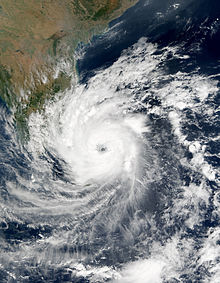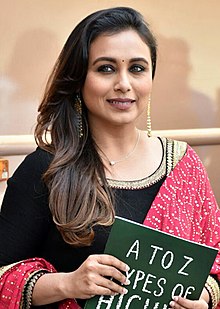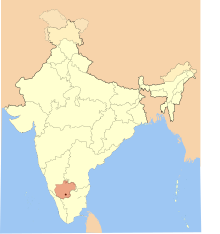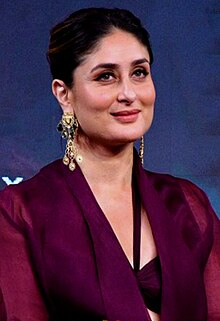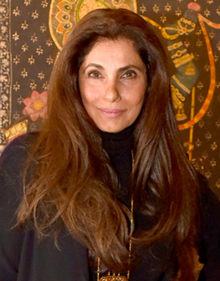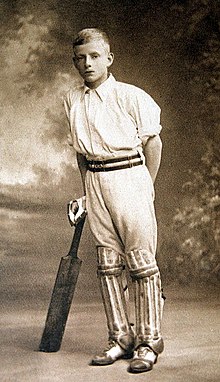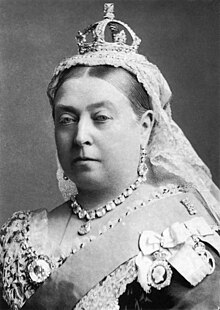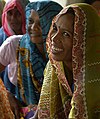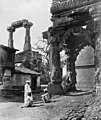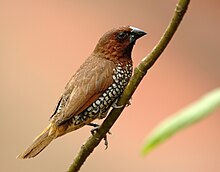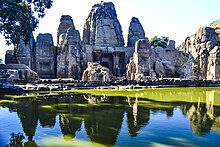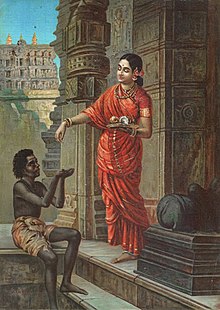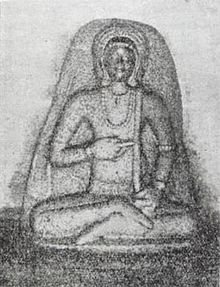Portal maintenance status: (June 2018)
|
Introduction

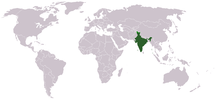
India, officially the Republic of India, is a country in South Asia. It is the seventh-largest country in the world by area and the most populous country. Bounded by the Indian Ocean on the south, the Arabian Sea on the southwest, and the Bay of Bengal on the southeast, it shares land borders with Pakistan to the west; China, Nepal, and Bhutan to the north; and Bangladesh and Myanmar to the east. In the Indian Ocean, India is in the vicinity of Sri Lanka and the Maldives; its Andaman and Nicobar Islands share a maritime border with Thailand, Myanmar, and Indonesia. (Full article...)
 Featured article – show another
Featured article – show another
-
Image 1
Margaret Alice Murray FSA Scot FRAI (13 July 1863 – 13 November 1963) was an Anglo-Indian Egyptologist, archaeologist, anthropologist, historian, and folklorist. The first woman to be appointed as a lecturer in archaeology in the United Kingdom, she worked at University College London (UCL) from 1898 to 1935. She served as president of the Folklore Society from 1953 to 1955, and published widely over the course of her career.
Born to a wealthy middle-class English family in Calcutta, British India, Murray divided her youth between India, Britain, and Germany, training as both a nurse and a social worker. Moving to London, in 1894 she began studying Egyptology at UCL, developing a friendship with department head Flinders Petrie, who encouraged her early academic publications and appointed her junior lecturer in 1898. In 1902–03, she took part in Petrie's excavations at Abydos, Egypt, there discovering the Osireion temple and the following season investigated the Saqqara cemetery, both of which established her reputation in Egyptology. Supplementing her UCL wage by giving public classes and lectures at the British Museum and Manchester Museum, it was at the latter in 1908 that she led the unwrapping of Khnum-nakht, one of the mummies recovered from the Tomb of two Brothers – the first time that a woman had publicly unwrapped a mummy. Recognising that British Egyptomania reflected the existence of a widespread public interest in Ancient Egypt, Murray wrote several books on Egyptology targeted at a general audience. (Full article...) -
Image 2
Kangna Amardeep Ranaut (pronounced [kəŋɡənaː raːɳoːʈʰ]; born 23 March 1986) is an Indian actress, filmmaker, and politician serving as a Member of Parliament, Lok Sabha from Mandi since June 2024. Known for her portrayals of strong-willed, unconventional women in female-led Hindi films, she is the recipient of several awards, including four National Film Awards and five Filmfare Awards, and has featured six times in Forbes India's Celebrity 100 list. In 2020, the Government of India honoured her with the Padma Shri, the country's fourth-highest civilian award.
At the age of sixteen, Ranaut briefly took up modelling before being trained under theatre director Arvind Gaur. She made her film debut in the 2006 thriller Gangster, for which she was awarded the Filmfare Award for Best Female Debut, and received praise for portraying emotionally intense characters in the dramas Woh Lamhe... (2006), Life in a... Metro (2007) and Fashion (2008). For the last of these, she won the National Film Award for Best Supporting Actress. She appeared in the commercially successful films Raaz: The Mystery Continues (2009) and Once Upon a Time in Mumbaai (2010) but was criticised for being typecast in neurotic roles. A comic role in Tanu Weds Manu (2011) was well-received, though this was followed by a series of brief, glamorous roles in films that failed to propel her career forward. (Full article...) -
Image 3
Typhoon Gay, also known as the Kavali Cyclone of 1989, was a small but powerful tropical cyclone which caused more than 800 fatalities in and around the Gulf of Thailand in November 1989. The worst typhoon to affect the Malay Peninsula in thirty-five years, Gay originated from a monsoon trough over the Gulf of Thailand in early November. Owing to favorable atmospheric conditions, the storm rapidly intensified, attaining winds over 120 km/h (75 mph) by 3 November. Later that day, Gay became the first typhoon since 1891 to make landfall in Thailand, striking Chumphon Province with winds of 185 km/h (115 mph). The small storm emerged into the Bay of Bengal and gradually reorganized over the following days as it approached southeastern India. On 8 November, Gay attained its peak intensity as a Category 5-equivalent cyclone with winds of 260 km/h (160 mph). The cyclone then moved ashore near Kavali, Andhra Pradesh. Rapid weakening ensued inland, and Gay dissipated over Maharashtra early on 10 November.
The typhoon's rapid development took hundreds of vessels by surprise, leading to 275 offshore fatalities. Of these, 91 occurred after an oil drilling ship, the Seacrest, capsized amid 6–11 m (20–36 ft) swells. Across the Malay Peninsula, 588 people died from various storm-related incidents. Several towns in coastal Chumphon were destroyed. Losses throughout Thailand totaled ฿11 billion (US $497 million). Striking India as a powerful cyclone, Gay damaged or destroyed about 20,000 homes in Andhra Pradesh, leaving 100,000 people homeless. In that country, 69 deaths and ₹410 million (US $25.3 million) in damage were attributed to Gay. (Full article...) -
Image 4Kaif promoting Bharat in 2019
Katrina Kaif (pronounced [kəˈʈriːna kɛːf]; born Katrina Turquotte, 16 July 1983) is a British actress who works in Hindi-language films. One of the highest-paid actresses in India, she has received accolades, including four Screen Awards and four Zee Cine Awards, in addition to three Filmfare nominations. Though reception to her acting has varied, she is noted for her action film roles and her dancing ability.
Born in British Hong Kong, Kaif lived in several countries before she moved to London for three years. She received her first modelling assignment as a teenager and later pursued a career as a fashion model. At a fashion show in London, Indian filmmaker Kaizad Gustad cast her in Boom (2003), a critical and commercial failure. While Kaif established a successful modelling career in India, she initially had difficulty finding film roles due to her poor command of Hindi. After appearing in the Telugu film Malliswari (2004), Kaif earned commercial success in Bollywood with the romantic comedies Maine Pyaar Kyun Kiya? (2005) and Namastey London (2007). Further success followed with a series of box-office hits, but she was criticised for her acting, repetitive roles, and inclination to male-dominated films. (Full article...) -
Image 5Eega (transl. The Fly) is a 2012 Indian Telugu-language fantasy action film written and directed by S. S. Rajamouli. The film was produced by Sai Korrapati's Vaaraahi Chalana Chitram with an estimated budget of ₹30–40 crore (US$6–7 million). It was filmed simultaneously in Tamil with the title Naan Ee (transl. I, the Fly). The film stars Nani, Samantha, and Sudeepa. M. M. Keeravani composed the songs and the background score, while K. K. Senthil Kumar was the director of photography. Janardhana Maharshi and Crazy Mohan wrote the dialogue for the Telugu and Tamil versions, respectively.
The film's narrative is in the form of a bedtime story told by a father to his daughter. Its protagonist, Nani, who is in love with his neighbour Bindu, is murdered by a wealthy industrialist named Sudeep, who is attracted to Bindu and considers Nani a rival. Nani reincarnates as a housefly and tries to avenge his death and protect Bindu from an obsessive Sudeep. (Full article...) -
Image 6Lage Raho Munna Bhai (pronounced [ləˈɡeː rəˈɦoː mʊnːaːˈbʱaːi] ⓘ; translation: Keep Going, Munna Bro) is a 2006 Indian Hindi-language satirical comedy drama film written, edited and directed by Rajkumar Hirani, who also co-wrote the screenplay with Abhijat Joshi, and produced by Vidhu Vinod Chopra under the banner Vinod Chopra Films. A sequel to Munna Bhai M.B.B.S. (2003), the film is the second installment of the Munna Bhai series. Sanjay Dutt and Arshad Warsi reprised their roles as Munna Bhai and Circuit, respectively. New additions to the cast include Vidya Balan, Dilip Prabhavalkar and Dia Mirza, while several actors from the original, notably Jimmy Sheirgill and Boman Irani, appear in new roles.
In this film, the eponymous lead character, a don in the Mumbai underworld, begins to see visions of Mahatma Gandhi. Through his interactions with Gandhi, he begins to practice what he refers to as "Gandhigiri" (a neologism for "Gandhism") to help ordinary people solve their problems. (Full article...) -
Image 7
The 2000 Sri Lanka cyclone (IMD designation: BOB 06 JTWC designation: 04B) was the strongest tropical cyclone to strike Sri Lanka since 1978. The fourth tropical storm and the second severe cyclonic storm of the 2000 North Indian Ocean cyclone season, it developed from an area of disturbed weather on December 25, 2000. It moved westward, and quickly strengthened under favorable conditions to reach top wind speeds of 75 mph (121 km/h). The cyclone hit eastern Sri Lanka at peak strength, then weakened slightly while crossing the island before making landfall over southern India on December 28. The storm degenerated into a remnant low later that day, before merging with another trough on the next day.
The storm was the first cyclone over Sri Lanka with winds of at least hurricane strength since a cyclone of 1978 hit the island in the 1978 season, as well as the first tropical storm to hit the island since 1992. The storm was also the first December tropical cyclone of hurricane intensity in the Bay of Bengal since 1996. It produced heavy rainfall and strong winds, damaging or destroying tens of thousands of houses and leaving up to 500,000 homeless. At least nine people died as a result of the cyclone. (Full article...) -
Image 8Mukerji promoting Hichki in 2018
Rani Mukerji (pronounced [raːni mʊkʰərdʒi]; born 21 March 1978) is an Indian actress who works in Hindi films. Noted for her versatility, she is the recipient of multiple accolades, including eight Filmfare Awards. Mukerji has featured in listings of the leading and highest-paid actresses of the 2000s.
Born into the Mukherjee-Samarth family, Mukerji dabbled with acting as a teenager by starring in her father Ram Mukherjee's Bengali-language film Biyer Phool and in the social drama Raja Ki Aayegi Baaraat (both 1996). Mukerji had her first commercial success with the action film Ghulam and breakthrough with the romance Kuch Kuch Hota Hai (both 1998). Following a brief setback, the year 2002 marked a turning point for her when she was cast by Yash Raj Films as the star of the drama Saathiya. (Full article...) -
Image 9Osbert Guy Stanhope Crawford CBE FBA FSA (28 October 1886 – 28 November 1957) was a British archaeologist who specialised in the archaeology of prehistoric Britain and Sudan. A keen proponent of aerial archaeology, he spent most of his career as the archaeological officer of the Ordnance Survey (OS) and also wrote a range of books on archaeological subjects.
Born in Bombay, British India, to a wealthy middle-class Scottish family, Crawford moved to England as an infant and was raised by his aunts in London and Hampshire. He studied geography at Keble College, Oxford, and worked briefly in that field before devoting himself professionally to archaeology. Employed by the philanthropist Henry Wellcome, Crawford oversaw the excavation of Abu Geili in Sudan before returning to England shortly before the First World War. During the conflict he served in both the London Scottish Regiment and the Royal Flying Corps, where he was involved in ground and aerial reconnaissance along the Western Front. After an injury forced a period of convalescence in England, he returned to the Western Front, where he was captured by the German Army in 1918 and held as a prisoner of war until the end of the conflict. (Full article...) -
Image 10Margarita with a Straw is a 2014 Indian Hindi-language drama film directed by Shonali Bose. It stars Kalki Koechlin as an Indian teenager with cerebral palsy who relocates to America for her undergraduate education and comes of age following her complex relationship with a blind girl, played by Sayani Gupta. Revathi, Kuljeet Singh, and William Moseley play supporting roles. Produced by Bose in partnership with Viacom18 Motion Pictures, Margarita with a Straw was co-written by Bose and Nilesh Maniyar. The film deals with the challenging concepts of sexuality, inclusion, self-love, and self-acceptance.
Bose conceived the idea for the film in January 2011 during a conversation with Malini Chib, her cousin and a disability rights activist, about the latter's desire to have a normal sex life. Inspired by Chib's story, Bose wrote the first draft of the film's script. After winning a Sundance Mahindra Global Filmmaker Award for the draft, she modified the script to reflect her own perspective, incorporating several personal experiences into the narrative. Bose completed the screenplay with co-writer Maniyar and the advisory council of the Sundance Institute. (Full article...) -
Image 11Taare Zameen Par (lit. 'Stars on Earth'), also known as Like Stars on Earth in English, is a 2007 Indian Hindi-language psychological drama film produced and directed by Aamir Khan. It stars Khan himself, with Darsheel Safary, Tanay Chheda, Vipin Sharma and Tisca Chopra. It explores the life and imagination of Ishaan (Safary), an artistically gifted 8-year-old boy whose poor academic performance leads his parents to send him to a boarding school, where a new art teacher Nikumbh (Khan) suspects that he is dyslexic and helps him to overcome his reading disorder.
Creative director and writer Amole Gupte developed the idea with his wife Deepa Bhatia, who was the film's editor. Shankar–Ehsaan–Loy composed the score, and Prasoon Joshi wrote the lyrics for many of the songs. Principal photography took place in Mumbai, and in Panchgani's New Era High School, where some of the school's students participated in the filming. (Full article...) -
Image 12
Sonam Kapoor Ahuja (pronounced [soːnəm kəˈpuːr]; born 9 June 1985) is an Indian actress who works in Hindi films. She has received several awards, including a National Film Award and a Filmfare Award. One of the highest-paid Hindi film actresses in the 2010s, Kapoor appeared in Forbes India's Celebrity 100 list from 2012 to 2016.
Kapoor, the daughter of actor Anil Kapoor, began her career as an assistant director on filmmaker Sanjay Leela Bhansali's 2005 film Black. She made her acting debut in Bhansali's romantic drama Saawariya (2007), a box office flop, and had her first commercial success with the romantic comedy I Hate Luv Storys (2010). This was followed by a series of commercial failures and repetitive roles, which garnered her negative reviews. The 2013 box office hit Raanjhanaa marked a turning point in Kapoor's career, garnering her praise and Best Actress nominations at several award ceremonies. (Full article...) -
Image 13
Western Ganga was an important ruling dynasty of ancient Karnataka in India which lasted from about 350 to 999 CE. They are known as "Western Gangas" to distinguish them from the Eastern Gangas who in later centuries ruled over Kalinga (modern Odisha and Northern Andhra Pradesh). The general belief is that the Western Gangas began their rule during a time when multiple native clans asserted their freedom due to the weakening of the Pallava empire in South India, a geo-political event sometimes attributed to the southern conquests of Samudra Gupta. The Western Ganga sovereignty lasted from about 350 to 550 CE, initially ruling from Kolar and later, moving their capital to Talakadu on the banks of the Kaveri River in modern Mysore district.
After the rise of the imperial Chalukyas of Badami, the Gangas accepted Chalukya overlordship and fought for the cause of their overlords against the Pallavas of Kanchi. The Chalukyas were replaced by the Rashtrakutas of Manyakheta in 753 CE as the dominant power in the Deccan. After a century of struggle for autonomy, the Western Gangas finally accepted Rashtrakuta overlordship and successfully fought alongside them against their foes, the Chola Dynasty of Tanjavur. In the late 10th century, north of Tungabhadra river, the Rashtrakutas were replaced by the emerging Western Chalukya Empire and the Chola Dynasty saw renewed power south of the Kaveri river. The defeat of the Western Gangas by Cholas around 1000 resulted in the end of the Ganga influence over the region. (Full article...) -
Image 14Chandralekha (also spelt Chandraleka) is a 1948 Indian historical adventure film produced and directed by S. S. Vasan of Gemini Studios. Starring T. R. Rajakumari, M. K. Radha and Ranjan, the film follows two brothers (Veerasimhan and Sasankan) who fight over ruling their father's kingdom and marrying a village dancer, Chandralekha.
Development began during the early 1940s when, after two successive box-office hits, Vasan announced that his next film would be entitled Chandralekha. However, when he launched an advertising campaign for the film he only had the name of the heroine from a storyline he had rejected. Veppathur Kittoo (one of Vasan's storyboard artists) developed a story based on a chapter of George W. M. Reynolds' novel, Robert Macaire: or, The French bandit in England. Original director T. G. Raghavachari left the film more than halfway through because of disagreements with Vasan, who took over in his directorial debut. (Full article...) -
Image 15The political history of medieval Karnataka spans the 4th to the 16th centuries in Karnataka region of India. The medieval era spans several periods of time from the earliest native kingdoms and imperialism; the successful domination of the Gangetic plains in northern India and rivalry with the empires of Tamilakam over the Vengi region; and the domination of the southern Deccan and consolidation against Muslim invasion. The origins of the rise of the Karnataka region as an independent power date back to the fourth-century birth of the Kadamba Dynasty of Banavasi which was the earliest of the native rulers to conduct administration in the native language of Kannada in addition to the official Sanskrit.
In the southern regions of Karnataka, the Western Gangas of Talakad were contemporaries of the Kadambas. The Kadambas and Gangas were followed by the imperial dynasties of the Badami Chalukya Empire, the Rashtrakuta Empire, the Western Chalukya Empire, the Hoysala Empire and the Vijayanagara Empire, all patronising the ancient Indic religions while showing tolerance to the new cultures arriving from the west of the subcontinent. The Muslim invasion of the Deccan resulted in the breaking away of the feudatory Sultanates in the 14th century. The rule of the Bahamani Sultanate of Bidar and the Bijapur Sultanate from the northern Deccan region caused a mingling of the ancient Hindu traditions with the nascent Islamic culture in the region. The hereditary ruling families and clans ably served the large empires and upheld the local culture and traditions. The fall of the Vijayanagara Empire in 1565 brought about a slow disintegration of Kannada-speaking regions into minor kingdoms that struggled to maintain autonomy in an age dominated by foreigners until unification and independence in 1947. (Full article...) -
Image 16
Kareena Kapoor Khan (pronounced [kəˈriːna kəˈpuːr xɑːn]; née Kapoor; born 21 September 1980) is an Indian actress. A prolific leading lady of Hindi cinema since 2000, she is noted for her roles in a range of film genres—from romantic comedies to crime dramas. Kapoor is the recipient of several awards, including six Filmfare Awards, and as of 2024, is one of Hindi cinema's highest-paid actresses.
Born into the Kapoor family, she is the daughter of actors Babita and Randhir Kapoor, and the younger sister of actress Karisma Kapoor. After making her acting debut in 2000 in Refugee, Kapoor established herself the following year with several roles, including in the top-grossing drama Kabhi Khushi Kabhie Gham.... This was followed by a series of commercial failures and negative reviews for her repetitive roles. An against-type performance as a sex worker in the 2004 drama Chameli marked a turning point in her career. She earned critical recognition for her portrayal of a riot victim in the 2004 drama Dev and a character based on Desdemona in the 2006 crime film Omkara. Her performance as a loquacious woman in the romantic comedy Jab We Met (2007) earned her the Filmfare Award for Best Actress. (Full article...) -
Image 17
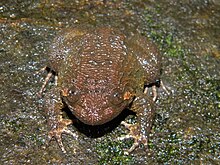
Nyctibatrachus major, the Malabar night frog, large wrinkled frog, or Boulenger's narrow-eyed frog is a species of frog in the family Nyctibatrachidae, commonly known as the robust frogs. It was described in 1882 by the zoologist George Albert Boulenger, and is the type species of the genus Nyctibatrachus. It is a large frog for its genus, with an adult snout–vent length of 31.5–52.0 mm (1.24–2.05 in) for males and 43.7–54.2 mm (1.72–2.13 in) for females. It is mainly brownish to greyish in colour, with a dark greyish-brown upperside, a greyish-white underside, and light grey sides. It also has a variety of grey or brown markings. When preserved in ethanol, it is mostly greyish-brown to grey, with whitish sides. Sexes can be told apart by the presence of the femoral glands (bulbous glands near the inner thigh) in males.
The species is endemic to the Western Ghats mountain range of India, where it is found in Kerala, Tamil Nadu, and Karnataka. Adults inhabit fast-moving forest streams at elevations of up to 900 m (3,000 ft) and have highly specific habitat requirements. Adults are mostly found in or near water and are nocturnal; subadults can be found during both the night and day. Its diet mainly consists of other frogs and insect larvae. Over a period of several days or weeks, females lay multiple small clutches of eggs on leaves and rocks overhanging water; tadpoles drop into the water below on hatching. The species is currently classified as being vulnerable on the IUCN Red List owing to its small and fragmented range and ongoing habitat degradation. Threats to the species include habitat loss, increased human presence near the streams it inhabits, and possibly nitrate pollution caused by fertiliser overuse. (Full article...) -
Image 18Mughal-e-Azam (transl. The Great Mughal) is a 1960 Indian epic historical drama film produced and directed by K. Asif. Starring Prithviraj Kapoor, Dilip Kumar, Madhubala, and Durga Khote, it follows the love affair between Mughal Prince Salim (who went on to become Emperor Jahangir) and Anarkali, a court dancer. Salim's father, Emperor Akbar, disapproves of the relationship, which leads to a war between father and son.
The development of Mughal-e-Azam began in 1944, when Asif read a 1922 play called Anarkali, by the playwright Imtiaz Ali Taj, which is set in the reign of Emperor Akbar (1556–1605). Production was plagued by delays and financial uncertainty. Before its principal photography began in the early 1950s, the project had lost a financier and undergone a complete change of cast. Mughal-e-Azam cost more to produce than any previous Indian motion picture; the budget for a single song sequence exceeded that typical for an entire film of the period. The soundtrack, inspired by Indian classical and folk music, comprises 12 songs voiced by playback singer Lata Mangeshkar along with Mohammed Rafi, Shamshad Begum, and classical singer Bade Ghulam Ali Khan, and is often cited among the finest in the history of Hindi cinema. (Full article...) -
Image 19
Dimple Kapadia (born 8 June 1957) is an Indian actress predominantly appearing in Hindi films. Born and raised in Mumbai by wealthy parents, she aspired to become an actress from a young age and received her first opportunity through her father's efforts to launch her in the film industry. She was discovered at age 14 by the filmmaker Raj Kapoor, who cast her in the title role of his teen romance Bobby (1973), which opened to major commercial success and gained her wide public recognition. Shortly before the film's release in 1973, she married the actor Rajesh Khanna and quit acting. Their daughters, Twinkle and Rinke Khanna, both briefly worked as actresses in their youth. Kapadia returned to films in 1984, two years after her separation from Khanna. Her comeback film Saagar, which was released a year later, revived her career. Both Bobby and Saagar won her Filmfare Awards for Best Actress. Through her work over the next decade, she established herself as one of Hindi cinema's leading actresses.
While her initial roles often relied on her perceived beauty and sex appeal, Kapadia was keen to challenge herself and expand her range. She was among the first actresses who starred in women-centred Hindi action films but found greater favour with critics when she took on more dramatic roles in both mainstream and neorealist parallel cinema. Appearing in films ranging from marital dramas to literary adaptations, she played troubled women sometimes deemed reflective of her personal experience, and received acclaim for her performances in Kaash (1987), Drishti (1990), Lekin... (1991), and Rudaali (1993). For her role as a professional mourner in Rudaali, she won the National Film Award for Best Actress and a Filmfare Critics Award. She also had supporting roles in the crime dramas Prahaar (1991), Angaar (1992), Gardish (1993) and Krantiveer (1994), the latter securing her another Filmfare Award. (Full article...) -
Image 20
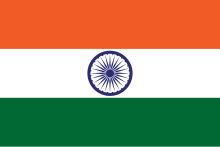
India, officially the Republic of India, is a country in South Asia. It is the seventh-largest country in the world by area and the most populous country. Bounded by the Indian Ocean on the south, the Arabian Sea on the southwest, and the Bay of Bengal on the southeast, it shares land borders with Pakistan to the west; China, Nepal, and Bhutan to the north; and Bangladesh and Myanmar to the east. In the Indian Ocean, India is in the vicinity of Sri Lanka and the Maldives; its Andaman and Nicobar Islands share a maritime border with Thailand, Myanmar, and Indonesia.
Modern humans arrived on the Indian subcontinent from Africa no later than 55,000 years ago. Their long occupation, initially in varying forms of isolation as hunter-gatherers, has made the region highly diverse, second only to Africa in human genetic diversity. Settled life emerged on the subcontinent in the western margins of the Indus river basin 9,000 years ago, evolving gradually into the Indus Valley Civilisation of the third millennium BCE. By at least 1200 BCE, an archaic form of Sanskrit, an Indo-European language, had diffused into India from the northwest. Its evidence today is found in the hymns of the Rigveda. Preserved by an oral tradition that was resolutely vigilant, the Rigveda records the dawning of Hinduism in India. The Dravidian languages of India were supplanted in the northern and western regions. By 400 BCE, stratification and exclusion by caste had emerged within Hinduism, and Buddhism and Jainism had arisen, proclaiming social orders unlinked to heredity. Early political consolidations gave rise to the loose-knit Maurya and Gupta Empires based in the Ganges Basin. Their collective era was suffused with wide-ranging creativity, but also marked by the declining status of women, and the incorporation of untouchability into an organised system of belief. In South India, the Middle kingdoms exported Dravidian-languages scripts and religious cultures to the kingdoms of Southeast Asia. (Full article...) -
Image 21Phoolan Devi (Hindi: [pʰuː.lən d̪eː.ʋiː], 10 August 1963 – 25 July 2001), popularly known as the Bandit Queen, was an Indian dacoit (bandit) who became a politician, serving as a member of parliament until her assassination. She was a woman of the Mallah subcaste who grew up in poverty in a village in the state of Uttar Pradesh, where her family was on the losing side of a land dispute which caused them many problems. After being married off at the age of eleven and being sexually abused by various people, she joined a gang of dacoits. Her gang robbed higher-caste villages and held up trains and vehicles. When she punished her rapists and evaded capture by the authorities, she became a heroine to the Other Backward Classes who saw her as a Robin Hood figure. Phoolan Devi was charged in absentia for the 1981 Behmai massacre, in which twenty Thakur men were killed, allegedly on her command. After this event, the Chief Minister of Uttar Pradesh resigned, and calls to apprehend her were amplified. She surrendered two years later in a carefully negotiated settlement and spent eleven years in Gwalior prison, awaiting trial.
Phoolan Devi was released in 1994 after her charges were set aside. She subsequently became a politician and was elected as a member of parliament for the Samajwadi Party in 1996. She lost her seat in 1998, but regained it the following year. She was the incumbent at the time of her death in 2001. She was assassinated outside her house by Sher Singh Rana, who was convicted for the murder in 2014. At the time of her death, she was still fighting against the reinstituted criminal charges, having lost a 1996 appeal to the Supreme Court to have the charges dropped. Phoolan Devi's worldwide fame grew after the release of the controversial 1994 film Bandit Queen, which told her life story in a way she did not approve of. Her life has also inspired several biographies and her dictated autobiography was entitled I, Phoolan Devi. There are varying accounts of her life because she told differing versions to suit her changing circumstances. (Full article...) -
Image 22Loev (pronounced love) is a 2015 Indian romantic drama film written and directed by Sudhanshu Saria. It stars Dhruv Ganesh and Shiv Panditt as two friends who set off to the Western Ghats for a weekend trip and focuses on their complex emotional and sexual relationship. It was Ganesh's final film, as he died from tuberculosis before its release. Loev also features Siddharth Menon and Rishabh Chaddha in supporting roles. The film's title is a deliberate misspelling of the word "love".
Saria wrote Loev's script while he was working on the draft of the unreleased film I Am Here and drew heavily from his personal experiences. It was eventually picked up for production by Arfi Lamba and Katherine Suckale despite Saria's own doubts on its viability. Principal photography took place at Mahabaleshwar, in the Western Ghats in peninsular India, and at Mumbai. The film was shot in the summer of 2014 over the course of sixteen days by the cinematographer Sherri Kauk in 2K resolution. It relied on crowdfunding and cost-cutting measures; its budget was relatively low at US$1 million. (Full article...) -
Image 23
Arthur Edward Jeune Collins (18 August 1885 – 11 November 1914) was an English cricketer and soldier. He held, for 116 years, the record of highest score in cricket: as a 13-year-old schoolboy, he scored 628 not out over four afternoons in June 1899. Collins's record-making innings drew a large crowd and increasing media interest; spectators at the Old Cliftonian match being played nearby were drawn away to watch the junior school house cricket match in which Collins was playing. Despite this achievement, Collins never played first-class cricket. Collins's 628 not out stood as the record score until January 2016 when an Indian boy, Pranav Dhanawade, scored 1009 in a single innings.
Collins joined the British Army in 1902 and studied at the Royal Military Academy, Woolwich, before becoming an officer in the Royal Engineers. He served in France during the First World War, where he was killed in action in 1914 during the First Battle of Ypres. Collins had been mentioned in despatches and also represented the Royal Military Academy at cricket and rugby union. (Full article...) -
Image 24Portrait by Alexander Bassano, 1882
Victoria (Alexandrina Victoria; 24 May 1819 – 22 January 1901) was Queen of the United Kingdom of Great Britain and Ireland from 20 June 1837 until her death in 1901. Her reign of 63 years and 216 days—which was longer than those of any of her predecessors—constituted the Victorian era. It was a period of industrial, political, scientific, and military change within the United Kingdom, and was marked by a great expansion of the British Empire. In 1876, the British Parliament voted to grant her the additional title of Empress of India.
Victoria was the daughter of Prince Edward, Duke of Kent and Strathearn (the fourth son of King George III), and Princess Victoria of Saxe-Coburg-Saalfeld. After the deaths of her father and grandfather in 1820, she was raised under close supervision by her mother and her comptroller, John Conroy. She inherited the throne aged 18 after her father's three elder brothers died without surviving legitimate issue. Victoria, a constitutional monarch, attempted privately to influence government policy and ministerial appointments; publicly, she became a national icon who was identified with strict standards of personal morality. (Full article...) -
Image 25

Tripura (/ˈtrɪpʊrə, -ərə/) is a state in northeastern India. The third-smallest state in the country, it covers 10,491 km2 (4,051 sq mi); and the seventh-least populous state with a population of 3.67 million. It is bordered by Assam and Mizoram to the east and by Bangladesh to the north, south and west. Tripura is divided into 8 districts and 23 sub-divisions, where Agartala is the capital and the largest city in the state. Tripura has 19 different tribal communities with a majority Bengali population. Bengali, English and Kokborok are the state's official languages.
The area of modern Tripura — ruled for several centuries by the Manikya Dynasty — was part of the Tripuri Kingdom (also known as Hill Tippera). It became a princely state under the British Raj during its tenure, and acceded to independent India in 1947. It merged with India in 1949 and was designated as a 'Part C State' (union territory). It became a full-fledged state of India in 1972. (Full article...)
Selected pictures
-
Image 1Photograph credit: Charles James SharpThe pied bush chat (Saxicola caprata) is a small passerine bird widely distributed in Asia. The males are black with white shoulder and vent patches, while the females are predominantly brownish. This species is insectivorous, and like other chats hunts from a prominent low perch. This female pied bush chat was photographed in Pench National Park, India.
-
Image 2
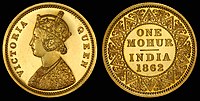 Coin design credit: East India Company and the Calcutta Mint; photographed by Andrew ShivaThe mohur is a gold coin that was formerly minted by several governments, including those of British India. It was usually equivalent in value to fifteen silver rupees. Gold mohurs issued by the British East India Company or the Crown are valuable collectors' items, and sell in auctions for high prices. The double mohur (minted between 1835 and 1918), with a value of thirty rupees, is the highest-denomination circulating coin ever issued in India. The 1835 two-mohur coin above was minted in the reign of King William IV, while the 1862 one-mohur coin below was minted in the reign of Queen Victoria; both are now part of the National Numismatic Collection at the National Museum of American History.
Coin design credit: East India Company and the Calcutta Mint; photographed by Andrew ShivaThe mohur is a gold coin that was formerly minted by several governments, including those of British India. It was usually equivalent in value to fifteen silver rupees. Gold mohurs issued by the British East India Company or the Crown are valuable collectors' items, and sell in auctions for high prices. The double mohur (minted between 1835 and 1918), with a value of thirty rupees, is the highest-denomination circulating coin ever issued in India. The 1835 two-mohur coin above was minted in the reign of King William IV, while the 1862 one-mohur coin below was minted in the reign of Queen Victoria; both are now part of the National Numismatic Collection at the National Museum of American History. -
Image 3Photograph credit: Charles J. SharpThe nilgai or blue bull (Boselaphus tragocamelus) is the largest Asian antelope and is endemic to the Indian subcontinent. The sole member of the genus Boselaphus, the species was described and given its binomial name by German zoologist Peter Simon Pallas in 1766. The nilgai stands 1–1.5 metres (3.3–4.9 ft) at the shoulder; males weigh 109–288 kilograms (240–635 lb), and the lighter females 100–213 kilograms (220–470 lb). A sturdy thin-legged antelope, the nilgai is characterised by a sloping back, a deep neck with a white patch on the throat, a short crest of hair along the neck terminating in a tuft, and white facial spots. A column of pendant coarse hair hangs from the dewlap ridge below the white patch. Sexual dimorphism is prominent – while females and juveniles are orange to tawny, adult males have a bluish-grey coat. Only males possess horns, which are 15–24 centimetres (5.9–9.4 in) in length.
This picture shows a male nilgai in a potato field at Jamtra, in the Indian state of Madhya Pradesh. -
Image 4Photograph credit: Prathyush ThomasMacrotyloma uniflorum, commonly known as horse gram, is a legume native to tropical southern Asia. The plant grows from a rhizome, sending up annual shoots to a height of 60 cm (24 in). The flowers are cream, yellow or pale green and are followed by short pods. The seeds, pictured here, have been consumed in India for at least 4,000 years and are used both for animal feed and human consumption, including Ayurvedic cuisine. In other tropical countries in southeastern Asia, and in northern Australia, the plant is grown mainly as a fodder crop and for use as green manure. It is a drought-tolerant plant, largely cultivated in areas with low rainfall.
-
Image 5Photograph: Arthur Chapman; edit: Papa Lima Whiskey and Ryan KaldariBrahmaea wallichii, also known as the owl moth, is a moth from the family Brahmaeidae. With a wingspan of about 90–160 mm (3.5–6.3 in), it is one of the largest species of Brahmin moth. This nocturnal species is found in India, Bhutan, Myanmar, China, Taiwan and Japan.
-
Image 6Photograph credit: Rucha Karkarey; edited by John HarrisonThe round ribbontail ray (Taeniura meyeni) is a species of stingray in the family Dasyatidae, found throughout the nearshore waters of the tropical Indo-Pacific region. Reaching 1.8 m (6 ft) across, this large ray is characterized by a thick, rounded pectoral fin disc covered by small tubercles on top, and a relatively short tail bearing a single venomous spine. The ray is well-camouflaged when lying on the seabed; it is largely nocturnal, and preys on molluscs, crustaceans and bony fish. Mature females bear litters of up to seven pups, which are fed during gestation on "uterine milk", a product secreted by the walls of the oviduct. This round ribbontail ray was photographed in Lakshadweep, India.
-
Image 7Photo: YannWomen of the Gondi, the largest tribe of Indian aboriginals in central India. They are classified as a Scheduled Tribe in most Indian states. The Gondi language is related to Telugu and other Dravidian languages. About half of Gonds speak Gondi languages, while the rest speak Indo-Aryan languages including Hindi. For many years during the British colonial period, the Gonds were considered to have performed human sacrifices, although this notion was later discredited.
-
Image 8Photograph: JJ HarrisonThe Siberian rubythroat (Luscinia calliope) is a small passerine bird generally considered to be an Old World flycatcher of the family Muscicapidae. This migratory insectivorous species breeds in mixed coniferous forest with undergrowth in Siberia, where it nests near the ground. It winters in Thailand, India and Indonesia. It is an extremely rare vagrant to Western Europe and the Aleutian Islands.
-
Image 9Photograph: Muhammad Mahdi KarimAlstroemeria × hybrida, an Alstroemeria hybrid, at the Lal Bagh Botanical Gardens in Bangalore, India. The genus consists of some 120 species and is native to South America.
-
Image 10Photograph: Muhammad Mahdi KarimA panoramic view of Bangalore from Corporation Circle, with UB City to the left and Richmond area to the right. Kanteerava Indoor Stadium is in the foreground. The third largest city in India, the city is known as the Silicon Valley of India for its numerous IT exports.
-
Image 11Bangalore Town Hall is a neoclassical municipal building in Bangalore, India. It is sometimes known, after a former president of Bangalore, as the Sir K. P. Puttanna Chetty Town Hall. Built by Mirza Ismail in 1935, it underwent renovations in 1990 at a cost of ₹6.5 million (US$371,400 at the time).
-
Image 12Photograph credit: Bourne & Shepherd; retouched by Yann ForgetThe Rudra Mahalaya Temple is an ancient temple complex at Siddhpur in the Patan district of Gujarat, India. The temple was completed in 1140 by Jayasimha Siddharaja, but in 1296, Alauddin Khalji sent an army under Ulugh Khan and Nusrat Khan, who dismantled the structure. In 1414 or 1415, the temple was further destroyed and the western part was converted into a congregational mosque by Muslim ruler Ahmad Shah I of the Muzaffarid dynasty. Apart from the mosque, the surviving fragments consist of two porches, a torana (ornamental gateway) and a few pillars.
-
Image 13A potter at work in Jaura, Madhya Pradesh, India. Pottery, defined by ASTM International as "all fired ceramic wares that contain clay when formed, except technical, structural, and refractory products", originated during the Neolithic period.
-
Image 14Papilio demoleus matingPhotograph: JkadavoorA mating pair of Papilio demoleus, a common and widespread Swallowtail butterfly, photographed at Kadavoor, Kerala, India. After successful mating the female goes from plant to plant, laying a single egg at a time on top of a leaf, and flies off as soon as the egg is laid.
-
Image 15Photograph: Muhammad Mahdi KarimThe Chota Imambara in Lucknow, Uttar Pradesh, India, is a mausoleum constructed by and for Muhammad Ali Shah, the third Nawab of Awadh, beginning in 1838.
 Featured list – show another
Featured list – show another
-
Image 1

The Padma Bhushan is the third-highest civilian award of the Republic of India. Instituted on 2 January 1954, the award is given for "distinguished service of a high order", without distinction of race, occupation, position, or sex. The recipients receive a Sanad, a certificate signed by the President of India and a circular-shaped medallion with no monetary association. The recipients are announced every year on Republic Day (26 January) and registered in The Gazette of India—a publication used for official government notices and released weekly by the Department of Publication, under the Ministry of Urban Development. The conferral of the award is not considered official without its publication in the Gazette. The name of recipient, whose award have been revoked or restored, both of which require the authority of the President, is archived and they are required to surrender their medal when their name is struck from the register; none of the conferments of Padma Bhushan during 1960–1969 have been revoked or restored. The recommendations are received from all the state and the union territory governments, as well as from Ministries of the Government of India, the Bharat Ratna and the Padma Vibhushan awardees, the Institutes of Excellence, the Ministers, the Chief Ministers and the Governors of State, and the Members of Parliament including private individuals.
When instituted in 1954, the Padma Bhushan was classified as "Dusra Varg" (Class II) under the three-tier Padma Vibhushan awards, which were preceded by the Bharat Ratna in hierarchy. On 15 January 1955, the Padma Vibhushan was reclassified into three different awards as the Padma Vibhushan, the Padma Bhushan and the Padma Shri. The criteria included "distinguished service of a high order in any field including service rendered by Government servants", but excluded those working with the public sector undertakings with the exception of doctors and scientists. The 1954 statutes did not allow posthumous awards; this was subsequently modified in the January 1955 statute. The design was also changed to the form that is currently in use; it portrays a circular-shaped toned bronze medallion 1+3⁄4 inches (44 mm) in diameter and 1⁄8 inch (3.2 mm) thick. The centrally placed pattern made of outer lines of a square of 1+3⁄16 inches (30 mm) side is embossed with a knob carved within each of the outer angles of the pattern. A raised circular space of diameter 1+1⁄16 inches (27 mm) is placed at the centre of the decoration. A centrally located lotus flower is embossed on the obverse side of the medal and the text "Padma" is placed above and the text "Bhushan" is placed below the lotus written in Devanagari script. The State Emblem of India is displayed in the centre of the reverse side, together with the national motto of India, "Satyameva Jayate" (Truth alone triumphs) in Devanagari script, which is inscribed on the lower edge. The rim, the edges and all embossing on either side is of standard gold with the text "Padma Bhushan" of gold gilt. The medal is suspended by a pink riband 1+1⁄4 inches (32 mm) in width with a broad white stripe in the middle. It is ranked fifth in the order of precedence of wearing of medals and decorations of the Indian civilian and military awards. (Full article...) -
Image 2

The Padma Bhushan is the third-highest civilian award of the Republic of India. Instituted on 2 January 1954, the award is given for "distinguished service of a high order", without distinction of race, occupation, position, or sex. The recipients receive a Sanad, a certificate signed by the President of India and a circular-shaped medallion with no monetary association. The recipients are announced every year on Republic Day (26 January) and registered in The Gazette of India, a publication used for official government notices and released weekly by the Department of Publication, under the Ministry of Urban Development. The conferral of the award is not considered official without its publication in the Gazette. The names of recipients whose awards have been revoked or restored, both of which require the authority of the President, are archived, and recipients who are struck from the register are required to surrender their medals; none of the conferments of Padma Bhushan during 1990–1999 have been revoked or restored. The recommendations are received from all the state and the union territory governments, as well as from Ministries of the Government of India, the Bharat Ratna and the Padma Vibhushan awardees, the Institutes of Excellence, the Ministers, the Chief Ministers and the Governors of State, and the Members of Parliament including private individuals.
When instituted in 1954, the Padma Bhushan was classified as "Dusra Varg" (Class II) under the three-tier Padma Vibhushan awards, which were preceded by the Bharat Ratna in hierarchy. On 15 January 1955, the Padma Vibhushan was reclassified into three different awards as the Padma Vibhushan, the Padma Bhushan and the Padma Shri. The criteria included "distinguished service of a high order in any field including service rendered by Government servants", but excluded those working with the public sector undertakings with the exception of doctors and scientists. The 1954 statutes did not allow posthumous awards; this was subsequently modified in the January 1955 statute. The design was also changed to the form that is currently in use; it portrays a circular-shaped toned bronze medallion 1+3⁄4 inches (44 mm) in diameter and 1⁄8 inch (3.2 mm) thick. The centrally placed pattern made of outer lines of a square of 1+3⁄16 inches (30 mm) side is embossed with a knob carved within each of the outer angles of the pattern. A raised circular space of diameter 1+1⁄16 inches (27 mm) is placed at the centre of the decoration. A centrally located lotus flower is embossed on the obverse side of the medal and the text "Padma" is placed above and the text "Bhushan" is placed below the lotus written in Devanagari script. The State Emblem of India is displayed in the centre of the reverse side, together with the national motto of India, "Satyameva Jayate" (Truth alone triumphs) in Devanagari script, which is inscribed on the lower edge. The rim, the edges and all embossing on either side is of standard gold with the text "Padma Bhushan" of gold gilt. The medal is suspended by a pink riband 1+1⁄4 inches (32 mm) in width with a broad white stripe in the middle. It is ranked fifth in the order of precedence of wearing of medals and decorations of the Indian civilian and military awards. (Full article...) -
Image 3

The United Nations Educational, Scientific and Cultural Organization (UNESCO) designates World Heritage Sites of outstanding universal value to cultural or natural heritage which have been nominated by countries which are signatories to the UNESCO World Heritage Convention, established in 1972. Cultural heritage consists of monuments (such as architectural works, monumental sculptures, or inscriptions), groups of buildings, and sites (including archaeological sites). Natural features (consisting of physical and biological formations), geological and physiographical formations (including habitats of threatened species of animals and plants), and natural sites which are important from the point of view of science, conservation or natural beauty, are defined as natural heritage. India accepted the convention on 14 November 1977, making its sites eligible for inclusion on the list.
There are 43 World Heritage Sites in India. Out of these, 35 are cultural, seven are natural, and one, Khangchendzonga National Park, is of mixed type, listed for both cultural and natural properties. India has the sixth-most sites worldwide. The first sites to be listed were the Ajanta Caves, Ellora Caves, Agra Fort, and Taj Mahal, all of which were inscribed in the 1983 session of the World Heritage Committee. The most recent site listed is the Moidams – the Mound-Burial System of the Ahom Dynasty, in 2024. At different times, two sites were listed as endangered: the Manas Wildlife Sanctuary was listed between 1992 and 2011 due to poaching and the activities of Bodo militias, and the monuments at Hampi were listed between 1999 and 2006 due to risks from increased traffic and new constructions in surroundings. One site is transnational: The Architectural Work of Le Corbusier is shared with six other countries. In addition, India has 56 sites on its tentative list. (Full article...) -
Image 4
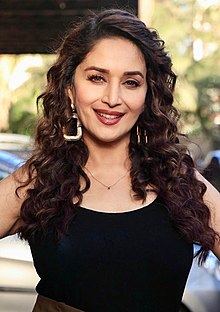
Dixit in 2019
Indian actress Madhuri Dixit made her acting debut in 1984 with Abodh where she portrayed a young bride. Dixit went on to appear in several films over the next three years, including the dramas Awara Baap (1985) and Swati (1986), though none of them garnered her much recognition. The role of Mohini in N. Chandra's action romance drama Tezaab (1988) proved to be a breakthrough for Dixit. The film went on to become the highest-grossing film of that year. For her performance, Dixit received a Best Actress nomination at Filmfare. She achieved further success by featuring as the female lead in several top-grossing action-dramas, including Ram Lakhan (1989), Tridev (1989), and Kishen Kanhaiya (1990). The role of a wealthy brat in the 1990 romantic drama Dil earned Dixit her first Filmfare Award for Best Actress. The following year, she starred in another box-office hit Saajan, and won a second Best Actress award at Filmfare for portraying the role of a strong woman who rebels against her manipulative mother-in-law in the 1992 drama Beta.
She featured alongside Jackie Shroff and Sanjay Dutt in the action thriller Khalnayak (1993), one of the highest-grossing films of that year. Subsequently, she played an avenger in the drama Anjaam (1994) to positive reviews. Dixit's subsequent release was Sooraj Barjatya's Hum Aapke Hain Koun..! (1994), a family drama which emerged as the highest-grossing Bollywood film to that point. The following year, she featured in Raja (1995) which was a blockbuster film of that year and Yaraana in which she played a woman who attempts an escape from her abusive husband. Both of her releases in 1996—Rajkumar and Prem Granth—were financial failures. Dixit's portrayal of a headstrong dancer in Yash Chopra's 1997 romance Dil To Pagal Hai was a major success, earning her a fourth Filmfare Award for Best Actress. She garnered critical acclaim for her work in the dramas Mrityudand (1997), Wajood (1998) and Pukar (2000). She portrayed five roles in the experimental film Gaja Gamini (2000). (Full article...) -
Image 5
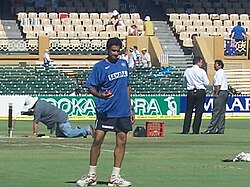
Anil Kumble, India's leading wicket-taker in Tests and ODIs
In cricket, a five-wicket haul (also known as a "five–for" or "fifer") refers to a bowler taking five or more wickets in a single innings. This is regarded as a notable achievement, as of October 2024[update] only 54 bowlers have taken 15 or more five-wicket hauls at international level in their cricketing careers.
Anil Kumble is a former Test and One Day International (ODI) cricketer who represented India. He is a right-arm leg spin (legbreak googly) bowler. Kumble has taken 619 wickets in Test cricket and 337 wickets in ODI cricket. With 37 five-wicket hauls, Kumble has the highest number of Test and combined international five-wicket hauls among Indian cricketers and fourth highest among all players, after Muttiah Muralitharan, Richard Hadlee, and Shane Warne.
Kumble made his ODI debut against Sri Lanka and his Test debut against England, both in 1990. His first five-wicket haul was against South Africa at Johannesburg (November, 1992) in the second Test of India's tour. He has claimed the most of his five-wicket hauls against Australia, ten of them, all in Test matches. His best performance was against Pakistan at the Feroz Shah Kotla in 1999; Kumble took all ten wickets during the second innings, just the second person to do so, after Jim Laker, and in the process ensured India of their first Test victory against Pakistan in twenty years. The feat also ranks as the second best bowling figures in Test history. Twenty of Kumble's Test cricket five-wicket hauls have come in victory for India, while five have been in defeats. Kumble has also taken two five-wicket hauls in ODIs. His first ODI five-wicket haul was against the West Indies during the final of the 1993 Hero Cup at Eden Gardens, Calcutta when he took six wickets for twelve runs, a record for India in One Day Internationals. The performance ensured India's victory and Kumble was adjudged man of the match. His other ODI five-wicket haul was against New Zealand at the Basin Reserve in 1994. (Full article...) -
Image 6Aadukalam (transl. Arena) is a 2011 Indian Tamil-language drama film written and directed by Vetrimaaran and produced by S. Kathiresan. Vetrimaaran co-wrote the dialogues with Vikram Sugumaran. The film stars Dhanush and Taapsee Pannu with Kishore, V. I. S. Jayapalan, Naren, and Murugadoss playing supporting roles. The musical score was composed by G. V. Prakash Kumar while the cinematography and editing were respectively handled by Velraj and Kishore Te. The film's story revolves around Karuppu who is the understudy of an experienced cockfighter, Pettaikaran. When Karuppu wins in a cockfight against Pettaikaran's rival Rathnasamy, Pettaikaran, who is initially happy, becomes jealous of Karuppu's newfound popularity and plots his downfall.
Produced on a budget of ₹150-200 million, Aadukalam was released on 14 January 2011 and grossed ₹300 million according to a February 2011 report by The Economic Times. The film garnered awards and nominations in several categories, with particular praise for its direction, screenplay, Dhanush's performance, music, cinematography, and editing. The film has won 33 awards from 52 nominations. (Full article...) -
Image 7

Vikram Vedha is a 2017 Indian Tamil-language neo-noir action thriller film directed and written by the husband and wife duo Pushkar–Gayathri and produced by S. Sashikanth under the banner of YNOT Studios. R. Madhavan and Vijay Sethupathi play the title characters Vikram and Vedha respectively. Shraddha Srinath, Kathir and Varalaxmi Sarathkumar play the other lead roles while Prem, Achyuth Kumar, Hareesh Peradi and Vivek Prasanna feature as supporting characters. Sam C. S. composed the film's soundtrack and score. Richard Kevin and P. S. Vinod was in charge of the editing and cinematography respectively.
A contemporary adaptation of the Indian folktale Baital Pachisi, the film follows Vikram, a police inspector who is decisive about good and evil, and the head of an encounter unit which is formed to track down and kill Vedha, a gangster. When the unit makes plans for another encounter, Vedha walks into the police station and voluntarily surrenders himself. He then tells Vikram three stories which bring about a change in the latter's perceptions of right and wrong. (Full article...) -
Image 8
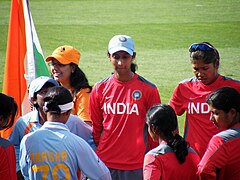
Members of the Indian cricket team before a Women's Cricket World Cup game in Sydney
A One Day International (ODI) is an international cricket match between two teams, each having ODI status, as determined by the International Cricket Council. The women's variant of the game is similar to the men's version, with minor modifications to umpiring and pitch requirements. The first women's ODI was played in 1973, between England and Australia. The Indian women's team played their first ever ODI match in 1978, against England, after the Women's Cricket Association of India was formed. The Women's Cricket Association of India was merged with the Board of Control for Cricket in India in 2006 as part of the International Cricket Council's initiative to develop women's cricket.
Since the team was formed, 144 women have represented India in ODI cricket. This list includes all players who have played at least one ODI match and is arranged in the order of debut appearance. Where more than one player won their first cap in the same match, those players are listed alphabetically by last name at the time of debut. (Full article...) -
Image 9

Koirala during a promotion for Bhoot Returns (2012)
Manisha Koirala is a Nepalese actress known for her work in Hindi and Tamil films. Koirala's acting debut was in the Nepali film Pheri Bhetaula (1989). Two years later, she made her Bollywood debut in Subhash Ghai's Saudagar, which was a commercial success. However, she followed this by appearing in a series of films which performed poorly at the box office, including First Love Letter (1991), Anmol (1993), and Dhanwan (1993). Koirala's career had a turnaround when she starred as the daughter of a freedom fighter in Vidhu Vinod Chopra's 1942: A Love Story (1994). Her performance was critically acclaimed and she earned a nomination for the Filmfare Award for Best Actress. The following year, Koirala received the Filmfare Critics Award for Best Actress, and the Filmfare Award for Best Actress – Tamil for playing a Muslim married to a Hindu during the 1992–1993 Bombay riots in the Mani Ratnam-directed Tamil drama Bombay (1995).
For playing the daughter of a mute and deaf couple in Sanjay Leela Bhansali's Khamoshi: The Musical (1996), Koirala garnered a second consecutive Filmfare Critics Award for Best Actress. She followed this with leading roles in Agni Sakshi (1996) and Gupt: The Hidden Truth (1997), which were among the highest-grossing Indian films of their respective years. She played a terrorist opposite Shah Rukh Khan in Dil Se.. (1998), the first Indian film to reach the top ten in the United Kingdom box office. However, Koirala's roles in films which performed poorly at the box office, such as Dil Ke Jharokhe Mein (1997), and Achanak (1998), led to a decline in her film career. She made her television debut in 2000 as the co-host of the game show Sawaal Dus Crore Ka with Anupam Kher. The show's poor ratings led to both Kher and Koirala being fired. For her role as a gangster's girlfriend in Ram Gopal Varma's 2002 crime drama Company, she received her third Filmfare Critics Award for Best Actress. Koirala also appeared in the controversial film Ek Chhotisi Love Story in which she played a woman secretly spied upon by a teenage voyeur. The following year, her portrayal of Bengali writer Sushmita Banerjee in the drama Escape from Taliban garnered her the Bengal Film Journalists' Association Award for Best Actress (Hindi). (Full article...) -
Image 10Vidya at the 63rd Filmfare Awards, 2018
Vidya Balan is an Indian actress who appears primarily in Hindi films. She has received several awards, including a National Film Award, seven Filmfare Awards, six Screen Awards, four International Indian Film Academy Awards, and five awards each from the Producers Guild and Zee Cine award ceremonies.
Vidya made her debut in 2003 with a leading role in the Bengali film Bhalo Theko, for which she won the Anandalok Award for Best Actress. In 2005, she had her first Bollywood release with the musical drama Parineeta, which garnered her a Best Female Debut award and a Best Actress nomination at the Filmfare Awards ceremony. For the role of a radio jockey in the 2006 horror comedy film Lage Raho Munna Bhai, she was nominated for the IIFA Award for Best Actress. In 2007, Vidya featured in five films. She portrayed a woman suffering from multiple sclerosis in the semi-biographical drama Guru and a dissociative identity disorder patient in the psychological thriller Bhool Bhulaiyaa. For the latter, she was nominated for a Filmfare Award for Best Actress. (Full article...) -
Image 11
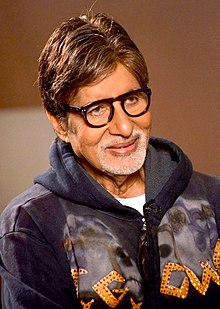
Piku is a 2015 Indian comedy-drama film directed by Shoojit Sircar and produced by N.P. Singh, Ronnie Lahiri and Sneha Rajani. The film stars Deepika Padukone as the eponymous protagonist, alongside Amitabh Bachchan and Irrfan Khan. Moushumi Chatterjee and Jisshu Sengupta play supporting roles. It was written by Juhi Chaturvedi and the musical score was composed by Anupam Roy. Piku tells the story of a headstrong Bengali architect, who along with her hypochondriac father and a helpful businessman embark on a road trip from New Delhi to Kolkata.
Made on an estimated budget of ₹420 million (US$5.0 million), Piku was released on 8 May 2015, and grossed approximately ₹1.41 billion (US$17 million) worldwide. The film garnered awards and nominations in several categories, with particular praise for its writing, music, and the performances of Padukone and Bachchan. As of June 2016, the film has won a minimum of 35 awards. (Full article...) -
Image 12

Rai Bachchan in 2023
Aishwarya Rai Bachchan is an Indian actress who has appeared in 48 films in five languages, predominantly in Hindi and Tamil. She made her acting debut in 1997 with dual role in Mani Ratnam's Tamil political drama film Iruvar, and her Bollywood debut that same year in the romantic comedy Aur Pyaar Ho Gaya opposite Bobby Deol. Rai followed it with a leading role in Jeans (1998), a high-profile Tamil film that was submitted as India's official entry to the Academy Awards. She won the Filmfare Award for Best Actress for her breakthrough role in Sanjay Leela Bhansali's romantic drama Hum Dil De Chuke Sanam and starred as a singer in the musical drama Taal (both 1999).
Rai had six film releases in 2000, including Kandukondain Kandukondain, a Tamil adaptation of Jane Austen's novel Sense and Sensibility, and Aditya Chopra's romantic drama Mohabbatein. In 2002, Rai starred opposite Shah Rukh Khan in Bhansali's period romance Devdas, an adaptation of the novel of the same name. Her performance in the top-grossing production earned her a second Best Actress award at Filmfare. In 2003, Rai played a sexually repressed widow in Rituparno Ghosh's Bengali film Chokher Bali, a sleeper hit. However, the failure of her two Hindi film releases of the year—Dil Ka Rishta and Kuch Naa Kaho—led to a setback in her Bollywood career. The following year, Rai played a character based on Elizabeth Bennet in a Bollywood-style adaptation of Austen's novel Pride and Prejudice, entitled Bride and Prejudice, a British production directed by Gurinder Chadha. Also in 2004, she reunited with Ghosh to play an unhappily married woman in the drama Raincoat. (Full article...) -
Image 13

Kapil Dev is India's third highest wicket-taker in Test cricket.
Kapil Dev is a former Test and One Day International (ODI) cricketer who represented India between 1978 and 1994. He took 24 five-wicket hauls during his international career. In cricket, a five-wicket haul—also known as a five-for or fifer—refers to a bowler taking five or more wickets in a single innings. This is regarded as a notable achievement, and as of October 2024[update], only 54 bowlers have taken 15 or more five-wicket hauls at international level in their cricketing careers. A right-arm fast bowler, Kapil Dev took 434 wickets in Test cricket and 253 in ODIs. With 23 five-wicket hauls in Tests, he has the third highest number of international five-wicket hauls among Indian cricketers as of 2012, after Anil Kumble and Harbhajan Singh. Kapil Dev was named by the Wisden as one of their Cricketers of the Year in 1983 and Indian Cricketer of the Century in 2002. Eight years later, the International Cricket Council (ICC) inducted him into the ICC Cricket Hall of Fame. As of 2012, Kapil Dev also holds the record for being the only player to have taken more than 400 wickets and scored over 5,000 runs in Tests.
Kapil Dev made his Test and ODI debuts against Pakistan, both in 1978. His first five-wicket haul came a year later against England during the first Test of India's tour. His career-best bowling figures in an innings of nine for 83 was achieved in 1983 against the West Indies in Ahmedabad. In Tests, Kapil Dev was most successful against Pakistan and Australia, with seven five-wicket hauls against each of them. He took his only five-wicket haul in ODIs against Australia during the 1983 Cricket World Cup. (Full article...) -
Image 14

Rajinikanth at the audio release of Enthiran (2010)
Rajinikanth is an Indian actor, film producer, screenwriter and also a playback singer who has appeared predominantly in Tamil cinema. He began his film career by playing antagonistic and supporting roles before graduating to a lead actor. After starring in numerous commercially successful films throughout the 1980s and 1990s, he has continued to hold a matinée idol status in the popular culture of Tamil Nadu. Writing for Slate, Grady Hendrix called him the "biggest movie star you've probably never heard of." Rajinikanth has also worked in other Indian film industries such as Hindi, Telugu, Kannada and Malayalam.
He made his cinematic debut with K. Balachander's 1975 Tamil drama Apoorva Raagangal, in which he played a minor role of an abusive husband. He had his first major role in Balachander's Telugu drama film Anthuleni Katha (1976), and got his breakthrough in Tamil with Moondru Mudichu (1976)—also directed by Balachander. His style and mannerisms in the latter earned recognition from the audience. In 1977, he acted in 15 films, playing negative characters in most of them, including Avargal, 16 Vayathinile, Aadu Puli Attam and Gaayathri. He had positive roles in Kavikkuyil, the Kannada film Sahodarara Savaal, and the Telugu film Chilakamma Cheppindi, in which he played the protagonist for the first time in his career. His role as a failed lover in S. P. Muthuraman's Bhuvana Oru Kelvi Kuri (1977) won him critical acclaim. In 1978, he was cast as the main lead in the Tamil film Bairavi. The same year, he received critical acclaim for his roles in Mullum Malarum and Aval Appadithan; the former earned him a Tamil Nadu State Film Award Special Prize for Best Actor. He made his Malayalam cinema debut with I. V. Sasi's fantasy Allauddinum Albhutha Vilakkum (1979), an adaptation of a story from One Thousand and One Nights. By the end of the decade, he had worked in all South Indian languages and established a career in Tamil cinema. (Full article...) -
Image 15
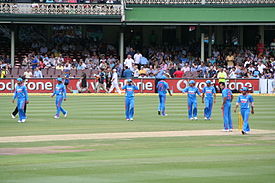
The Indian national cricket team at the Sydney Cricket Ground in 2012.
The India national cricket team represents India in international cricket and is a full member of the International Cricket Council with Test and One Day International (ODI) status. They first competed in international cricket in 1932, when they played against England in a three-day Test match; England won the match by 158 runs. India's first Test series as an independent country was against Australia. They secured their first Test win against England in 1952 at Madras Cricket Club Ground. As of 11 April 2024[update], India have played 579 Test matches; they have won 178 matches, lost 178 matches, and 222 matches were drawn with one being tied. India played their first ODI match against England in 1974, but registered their first win against East Africa in 1975. As of 11 April 2024[update], India have played 1055 ODI matches, winning 559 matches and losing 443; 9 matches were tied and 44 matches had no result. They also won the 1983 and 2011 Cricket World Cups, along with the 2002 and the 2013 ICC Champions Trophy. India played their first Twenty20 International (T20I) against South Africa in 2006, winning the match by six wickets, and won the inaugural ICC World Twenty20 in 2007. As of 14 July 2024[update], they have played 232 T20I matches and won 152 of them; 69 were lost, with 4 super-over/bowl-out wins (after being tied), one tied (without a super over) and 6 having no result.
India have faced ten teams in Test cricket, with their most frequent opponent being England, against whom they have played 136 matches. India have registered more wins against England than against any other team, with 35. In ODI matches, India have played against 20 teams. They have played against Sri Lanka more frequently in ODI matches, with a winning percentage of 63.37 in 99 out of 168 matches. India have defeated Sri Lanka on 99 occasions, which is their best record in ODIs. The team have played 17 countries in T20Is, and have played 31 matches with Australia. They also have recorded the most victories against Australia, Sri Lanka and the West Indies, defeating all of them in nineteen matches. (Full article...) -
Image 16
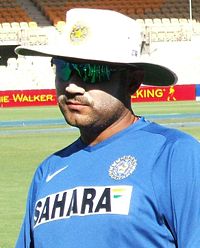
Virender Sehwag scored 23 centuries in Test matches and 15 in One Day Internationals for India.
Virender Sehwag is an Indian cricketer whose aggressive batting has found success at the top of the batting order. He has scored centuries (100 or more runs) on 23 occasions in Test cricket and in 15 One Day International (ODI) matches but has not scored a century in a Twenty20 international.
In Tests, Sehwag has scored centuries against all the Test-cricket playing nations except Bangladesh and Zimbabwe, and is fifth on the list of leading Test century makers for India. In 2001, he became the eleventh Indian player to score a century on Test debut, with 105 runs against South Africa. His centuries have been scored at fourteen cricket grounds, eight of which were outside India. He has made six scores of 200 runs or more, of which a record three have come against Pakistan. One such innings, the 254 in Lahore, had him involved in a 410-run partnership with Rahul Dravid, which came within 3 runs of breaking the record for the highest first-wicket partnership in Tests, set by Pankaj Roy and Vinoo Mankad. The innings took only 247 balls and was the highest score at faster than a run a ball. Sehwag is the first Indian to score a triple century (300 or more runs), and has done so twice—309 against Pakistan in Multan in 2004 and 319 against South Africa in Chennai in 2008. The latter is the fastest triple century in Test cricket, the 300 coming up off just 278 balls, and is also the highest score with a strike rate over 100. It was also rated as one of the top 10 Test innings of all time by the ICC rankings, and received special mention along with his 201* in Galle, in which he carried his bat as he was named the Wisden Leading Cricketer in the World in 2008. He is one of the only four batsmen to score two triple centuries, alongside Sir Donald Bradman, Brian Lara and Chris Gayle. He scored 12 centuries that have been converted to scores of 150 or greater, a record for the most consecutive hundreds of over 150. He has been dismissed five times in the nineties. (Full article...) -
Image 17In the Republic of India, a chief minister is the head of government of each of the twenty-eight states and three of the eight union territories. According to the Constitution of India, at the state level, the governor is de jure head, but de facto executive authority rests with the chief minister. Following elections to the state legislative assembly, the governor usually invites the party (or coalition) with a majority of seats to form the state government. The governor appoints the chief minister, whose council of ministers are collectively responsible to the assembly. Out of the thirty incumbents, except Tamil Nadu's M. K. Stalin, all other Chief Ministers also act as the leader of the house in their legislative assemblies. Given they have the assembly's confidence, the chief minister's term is usually for a maximum of five years; there are no limits to the number of terms they can serve.
Two of the incumbents are women — Mamata Banerjee in West Bengal,
who has the longest continuous incumbency serving since 20 March 2011 (for 13 years, 189 days) and Atishi Marlena in Delhi. Atishi (aged 43) is the also the youngest incumbent chief minister, while Kerala's Pinarayi Vijayan (aged 79) is the oldest. Nitish Kumar of Bihar has served for the most terms (nine). Thirteen incumbents belong to the Bharatiya Janata Party, three to the Indian National Congress, and two to the Aam Aadmi Party. No other party has more than one chief minister in office. (Full article...) -
Image 18

The Padma Bhushan is the third-highest civilian award of the Republic of India. Instituted on 2 January 1954, the award is given for "distinguished service of a high order", without distinction of race, occupation, position, or sex. The recipients receive a Sanad, a certificate signed by the President of India and a circular-shaped medallion with no monetary association. The recipients are announced every year on Republic Day (26 January) and registered in The Gazette of India—a publication used for official government notices and released weekly by the Department of Publication, under the Ministry of Urban Development. The conferral of the award is not considered official without its publication in the Gazette. The name of recipient, whose award have been revoked or restored, both of which require the authority of the President, is archived and they are required to surrender their medal when their name is struck from the register; none of the conferments of Padma Bhushan during 1970–1979 have been revoked or restored. The recommendations are received from all the state and the union territory governments, as well as from Ministries of the Government of India, the Bharat Ratna and the Padma Vibhushan awardees, the Institutes of Excellence, the Ministers, the Chief Ministers and the Governors of State, and the Members of Parliament including private individuals.
When instituted in 1954, the Padma Bhushan was classified as "Dusra Varg" (Class II) under the three-tier Padma Vibhushan awards, which were preceded by the Bharat Ratna in hierarchy. On 15 January 1955, the Padma Vibhushan was reclassified into three different awards as the Padma Vibhushan, the Padma Bhushan and the Padma Shri. The criteria included "distinguished service of a high order in any field including service rendered by Government servants", but excluded those working with the public sector undertakings with the exception of doctors and scientists. The 1954 statutes did not allow posthumous awards; this was subsequently modified in the January 1955 statute. The design was also changed to the form that is currently in use; it portrays a circular-shaped toned bronze medallion 1+3⁄4 inches (44 mm) in diameter and 1⁄8 inch (3.2 mm) thick. The centrally placed pattern made of outer lines of a square of 1+3⁄16-inch (30 mm) side is embossed with a knob carved within each of the outer angles of the pattern. A raised circular space of diameter 1+1⁄16 inches (27 mm) is placed at the centre of the decoration. A centrally located lotus flower is embossed on the obverse side of the medal and the text "Padma" is placed above and the text "Bhushan" is placed below the lotus written in Devanagari script. The State Emblem of India is displayed in the centre of the reverse side, together with the national motto of India, "Satyameva Jayate" (Truth alone triumphs) in Devanagari script, which is inscribed on the lower edge. The rim, the edges and all embossing on either side is of standard gold with the text "Padma Bhushan" of gold gilt. The medal is suspended by a pink riband 1+1⁄4 inches (32 mm) in width with a broad white stripe in the middle. It is ranked fifth in the order of precedence of wearing of medals and decorations of the Indian civilian and military awards. (Full article...) -
Image 19The Sunrisers Hyderabad (often abbreviated as SRH) are a franchise cricket team based in Hyderabad, Telangana, that compete in the Indian Premier League (IPL). The team is owned by Kalanithi Maran of the Sun TV Network who won the bid for the franchise at ₹850.5 million per year on a five-year deal in 2012 following the termination of the previous Hyderabad-based franchise, Deccan Chargers, from the IPL. Having made its first IPL playoffs appearance in its debut season in 2013, the team has qualified for the playoffs every year since the 2016 season. They have reached the finals twice, most recently during the 2018 season, and won their only title in the 2016 season after defeating the Royal Challengers Bangalore by 8 runs in the Final.
As of June 2022[update], the team was captained by Kane Williamson and coached by Tom Moody with Simon Helmot as assistant coach, Muttiah Muralitharan and Dale Steyn as bowling coaches, Brian Lara as batting coach and Hemang Badani as fielding coach. The team has played its home matches in the 55,000-capacity Rajiv Gandhi International Cricket Stadium in Hyderabad since its inception. The coronavirus pandemic impacted the brand value of the Sunrisers Hyderabad which was estimated to be US$57.4million in 2020 as the overall brand of IPL was decreased to US$4.4billion, according to Brand Finance. (Full article...) -
Image 20Prithviraj Sukumaran is the recent winner in 2024
The Kerala State Film Award for Best Actor is an award, begun in 1969, presented annually at the Kerala State Film Awards of India to an actor for best performance in a Malayalam film. Until 1997, the awards were managed directly by the Department of Cultural Affairs of the Government of Kerala. Since 1998, the awards have been constituted by the Kerala State Chalachitra Academy, an autonomous, non-profit institution functioning under the Department of Cultural Affairs. The awardees are decided by a jury constituted every year. They are announced by the Minister for Cultural Affairs and are presented by the Chief Minister.
Throughout the years, accounting for ties and repeat winners, the government has presented 54 Best Actor awards to 35 actors. The recipients receive a figurine, a certificate, and a cash prize of ₹100,000 (US$1,200). Several actors have won the honour for more than one film in a given year. As of 2020, the only actor to have won the prize in consecutive years is Bharat Gopy, in 1982 and 1983. (Full article...) -
Image 21The state president of the Indian National Congress is the state-level highest command of the Indian National Congress (INC), responsible for leading in political campaigns at state level. State presidents shoulder a diverse array of roles and responsibilities integral to the effective functioning of the party at the state-level. Also known as the leader of the state and union territory party, a state president is chosen by the party president.
Being the higher decision-making body, state presidents actively contribute to the formulation of state-level policies, representing the party's stance on relevant issues and engaging in the development and implementation of election strategies during state elections. In addition, a state president is tasked with overseeing the organizational structure of the Pradesh Congress Committee, including the appointment and coordination of leaders at various levels, such as the district committee, block committee, and each panchayat development block or panchayat samiti. Serving as a spokesperson for the party in the state, they communicate the party's positions to the media and keep party members informed about policies and decisions. State presidents also play a pivotal role in building and maintaining the party's membership, reaching out to diverse sections of society and addressing their concerns to advance the party's agenda. (Full article...) -
Image 22

Vidya in 2023
Indian actress Vidya Balan made her acting debut in 1995 with the sitcom Hum Paanch, following which she made several unsuccessful attempts at a film career. Vidya then appeared in music videos for Euphoria, Pankaj Udhas, and Shubha Mudgal all directed by Pradeep Sarkar. She had her first film release with a leading role in Goutam Halder's Bengali film Bhalo Theko (2003). In 2005, she starred in Sarkar's Parineeta, an adaptation of Sarat Chandra Chattopadhyay's novel, which won her the Filmfare Award for Best Female Debut. Rajkumar Hirani's Lage Raho Munna Bhai (2006), a successful comedy sequel, saw her play a radio jockey opposite Sanjay Dutt.
Vidya played a variety of roles in 2007, including a woman suffering from multiple sclerosis in Mani Ratnam's drama Guru, a single mother in the comedy Heyy Babyy, and a dissociative identity disorder patient in the thriller Bhool Bhulaiyaa. All three films were commercially successful and established her as a leading lady. This was followed by two commercial failures in 2008. From 2009 to 2012, Vidya starred in five consecutive films that garnered her critical and commercial success. She played the mother of a child afflicted with progeria in Paa (2009), a seductive widow in Ishqiya (2010), and the real-life character of Sabrina Lal in No One Killed Jessica (2011). For portraying the actress Silk in the biopic The Dirty Picture, Vidya won the National Film Award for Best Actress. She next played a pregnant woman seeking revenge in the thriller Kahaani (2012), directed by Sujoy Ghosh. She was awarded the Filmfare Award for Best Actress for her roles in Paa, The Dirty Picture, and Kahaani, and the Filmfare Critics Award for Best Actress for Ishqiya. (Full article...) -
Image 23

Priyanka Chopra's performance in Mary Kom garnered her several awards and nominations
Mary Kom is a 2014 Indian biographical sports drama film directed by Omung Kumar and produced by Sanjay Leela Bhansali and Viacom 18 Motion Pictures. The film features Priyanka Chopra in the lead role as the boxer Mary Kom, with Darshan Kumar and Sunil Thapa in supporting roles as her husband and mentor, Onler Kom and M. Narjit Singh respectively. The film was written by Saiwyn Quadras, with the cinematography provided by Keiko Nakahara while Bhansali co-edited the film with Rajesh G. Pandey. The film follows Kom's journey of becoming a boxer to her victory at the 2008 World Boxing Championships in Ningbo, China.
Before its theatrical release on 5 September 2014, the film premiered at the 2014 Toronto International Film Festival, where it became the first Hindi film to be screened on the opening night of the film festival. The film received generally positive reviews from critics and was a commercial success. It grossed ₹1.05 billion (US$13 million) at the box-office against a budget of ₹150 million (US$1.8 million). Mary Kom has received various awards and nominations, with praise for its direction, Chopra's performance, screenplay, editing, background score, and costume design. As of August 2015, the film has won 20 awards. (Full article...) -
Image 24
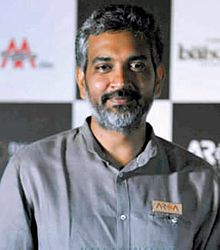
S. S. Rajamouli received several awards and nominations for directing the film.
Baahubali: The Beginning is a 2015 Indian epic historical fiction film written and directed by S. S. Rajamouli and produced by Arka Media Works. Shot simultaneously in Telugu and Tamil languages, the film stars Prabhas, Rana Daggubati, Anushka Shetty, and Tamannaah while Sathyaraj, Ramya Krishnan and Nassar appear in supporting roles. The soundtrack and music score was composed by M. M. Keeravani while K. K. Senthil Kumar provided the cinematography. Kotagiri Venkateswara Rao, Sabu Cyril and V. Srinivas Mohan were in charge of the film's editing, art direction and special effects respectively.
The first of two cinematic parts, The Beginning opened worldwide on 10 July 2015 to critical acclaim and record-breaking box-office success, becoming the highest-grossing film in India and the third-highest grossing Indian film worldwide, and the highest-grossing South Indian film. Grossing over ₹6.5 billion worldwide against a budget of ₹1.2 billion, the film became the first South Indian film, and the first non-Hindi film to gross over ₹1 billion in the dubbed Hindi version. The Beginning garnered several awards and nominations with praise for Rajamouli's direction, cinematography, production design, costumes and performances of the cast members. (Full article...) -
Image 25

Ajith Kumar in 2010
Ajith Kumar is an Indian actor who works mainly in Tamil cinema. Apart from a small role in the 1990 Tamil film En Veedu En Kanavar, his professional career began three years later with his debut as a lead actor in Tamil cinema with Amaravathi (1993). Despite being a moderate success, the film helped him obtain more modelling assignments. He followed it up the same year with Prema Pusthakam, his only Telugu film to date. After Amaravathi's release, Ajith opted against acting, and instead tried pursuing a career in auto racing. While training for an amateur race, he injured his back and underwent three major surgeries, leaving him bed-ridden for a year and a half. After recovering from the injury, he played supporting roles in Paasamalargal (1994) and Pavithra (1994). After this, he co-starred with Vijay in Rajavin Parvaiyile (1995). That same year, he had his breakthrough with the romantic thriller Aasai. His performance earned him critical acclaim and established him as an up-and-coming actor in Tamil cinema.
He was next seen as the main lead in Agathiyan's epistolary Kadhal Kottai (1996), a critical and commercial success. In 1997, he had five releases, all of which were commercial failures. Ajith's dual portrayal of twin brothers—where one is deaf-mute—in S. J. Suryah's Vaalee (1999) won him his first Filmfare Award for Best Tamil Actor. Impressed with his performance in that film, Rajiv Menon cast Ajith in the ensemble drama Kandukondain Kandukondain (2000) which was also commercial and critical success. The following year, he collaborated with debutant director AR Murugadoss on the action film Dheena. The film was successful in establishing his reputation as an action hero and earning him the nickname "Thala" ("leader"). He earned critical acclaim for his dual role performance in the vigilante film Citizen (2001), and the film was commercial success. and a Best Actor nomination at Filmfare for the drama Poovellam Un Vasam (2001). His last release of the year was Santosh Sivan's Hindi film Aśoka, where he played a brief antagonistic role opposite Shah Rukh Khan. His -role performance as twin brothers in K. S. Ravikumar's film Villain (2002) won him a second Filmfare Award for Best Tamil Actor. (Full article...)
 Good article – show another
Good article – show another
-
Image 1Maine Pyar Kiya (transl. I've loved) also known by the initialism MPK is a 1989 Indian Hindi-language romantic musical film directed by Sooraj Barjatya and his directorial debut, produced by Tarachand Barjatya, co-written by S. M. Ahale with Sooraj Barjatya and distributed by Rajshri Productions. The film had Salman Khan in the leading role with Bhagyashree making her acting debut, with Alok Nath, Mohnish Bahl, Reema Lagoo, Rajeev Verma, Ajit Vachani, and Laxmikant Berde in supporting roles. Maine Pyar Kiya tells the story of two individuals and relates their journey from friendship to how they fall in love but later have to fight family differences to be together.
Principal photography took place in Mumbai and various locations in Ooty. The film features a score and soundtrack composed by Raamlaxman, while Asad Bhopali wrote the lyrics. Maine Pyar Kiya is considered to be one of Khan's most iconic and loved films, and it became a cult favorite because of its songs, dialogues, and chemistry between Khan and Bhagyashree. The film also established the careers of the supporting cast including Mohnish Bahl and Laxmikant Berde. (Full article...) -
Image 2
Shivaji Rao Gaikwad (born 12 December 1950), known professionally as Rajinikanth, is an Indian actor who predominantly works in Tamil cinema. In a career spanning over five decades, he has done 170 films that includes films in Tamil, Hindi, Telugu, Kannada, Bengali, and Malayalam. He is widely regarded to be one of the most successful and popular actors in the history of Indian cinema. Known for his uniquely styled mannerism and one liners in films, he has a huge fan base internationally and has a cult following. The Government of India honoured him with Padma Bhushan in 2000, Padma Vibhushan in 2016, India's third and second highest civilian honours, and the highest award in the field of cinema Dadasaheb Phalke Award in the 67th National Film Awards ceremony (2019) for his contributions to Indian cinema. He has won many film awards including seven Tamil Nadu State Film Awards, a Nandi Award and one Filmfare Award.
Following his debut in K. Balachander's 1975 Tamil drama Apoorva Raagangal, Rajinikanth's acting career commenced with a brief phase of portraying antagonistic characters in Tamil films. His major positive role as a scorned lover in S. P. Muthuraman's Bhuvana Oru Kelvi Kuri (1977), 1978's Mullum Malarum and Aval Appadithan received him critical acclaim; the former earned him a Tamil Nadu State Film Award Special Prize for Best Actor. By the end of the decade, he had worked in all South Indian film industries and established a career in Tamil cinema. He then played dual roles in the action thriller Billa (1980), a remake of the Hindi film Don (1978). It was his biggest commercial success to that point, earned him stardom and gave him the action hero image. He starred in triple role in Moondru Mugam (1982), which earned him a special prize at the Tamil Nadu State Film Awards ceremony. The following year, he made his Hindi film debut with T. Rama Rao's top grossing Andhaa Kaanoon (1983). Nallavanukku Nallavan (1984) won him that year's Filmfare Award for Best Tamil Actor. In the latter half of the 1980s, he starred in several successful films in Tamil and Hindi, including Geraftaar (1985), Padikkadavan (1985), Mr. Bharath (1986), Dosti Dushmani (1986), Velaikaran (1987), Manithan (1987), Dharmathin Thalaivan (1988) and ChaalBaaz (1989). (Full article...) -
Image 3Satya (transl. Truth) is a 1998 Indian Hindi-language crime film, produced and directed by Ram Gopal Varma; written by Saurabh Shukla and Anurag Kashyap. It stars J. D. Chakravarthy, Urmila Matondkar and Manoj Bajpayee, alongside Saurabh Shukla, Aditya Shrivastava and Paresh Rawal. It is the first of Varma's Gangster trilogy about organised crime in India. The film follows Satya (Chakravarthy), an immigrant who comes to Mumbai looking for a job, befriends Bhiku Mhatre (Bajpayee) and is drawn into the Mumbai underworld.
Varma, initially planned to make an action film, but decided to make a film focusing on felonies after meeting some criminals. He hired Kashyap and Shukla to write the film, and opted to use lesser-known actors. The soundtrack and score were composed by Vishal Bhardwaj and Sandeep Chowta, respectively, while the lyrics were written by Gulzar. Its early cinematography was done by Gerard Hooper, who was replaced by Mazhar Kamran. The film was shot in Mumbai on a budget of ₹2.5 crore (US$300,000). (Full article...) -
Image 4
The 1996 Andhra Pradesh cyclone (also known as Cyclone 07B) was a small but powerful storm that left heavy damage in the Indian state of Andhra Pradesh. It formed on 4 November in the eastern Bay of Bengal. Moving westward, it quickly organized and developed a well-defined eye. On 6 November, the cyclone struck about 50 km (31 mi) south of Kakinada, Andhra Pradesh at peak intensity. The India Meteorological Department estimated peak winds of 145 km/h (90 mph), while the American-based Joint Typhoon Warning Center (JTWC) assessed peak winds of 215 km/h (135 mph). Soon after landfall, the cyclone weakened and dissipated by 7 November.
Ahead of the storm, about 225,000 families evacuated, although many towns lacked proper storm shelters. When the cyclone made landfall, it produced strong winds up to 100 km (62 mi) inland, dropped 210 mm (8.3 in) of rainfall across a 40 km (25 mi) region, and flooded over 250 villages along a 60 km (37 mi) portion of the coast. About 70% of the overall damage was in East Godavari district, where two villages were entirely destroyed. The storm destroyed 241,802 ha (597,510 acres) of crops and killed millions of cattle and chicken. Across Andhra Pradesh, the storm damaged 647,554 houses, including over 10,000 that were destroyed. Overall damage totaled ₹21.5 billion (equivalent to ₹120 billion or US$1.4 billion in 2023), comparable to a cyclone in 1977 that also hit Andhra Pradesh. There were 1,077 confirmed deaths with many others missing, although many of the dead were washed into the sea and were unlikely to be found. After the storm, the government and local Red Cross chapters helped residents recover from the damage, while the World Bank provided money to better prepare Andhra Pradesh for future storms. (Full article...) -
Image 5
Nerpa (renamed INS Chakra in Indian Navy service) is a 8,140-tonne (8,010-long-ton) Project 971 (or Project 518; NATO: Akula-class) nuclear-powered attack submarine. The construction of the submarine was started in Russia in 1993, but was suspended due to lack of funding. India then sponsored further construction and sea trials of the submarine provided it was leased to the Indian Navy for 10 years. It was launched as K-152 Nerpa in October 2008 and entered service with the Russian Navy in late 2009. The submarine was leased to the Indian Navy in 2011 after extensive trials, and was formally commissioned into service as INS Chakra with the Eastern Naval Command at a ceremony in Visakhapatnam on 4 April 2012. In June 2021 Chakra was spotted on the surface escorted by Indian and Russian warships in the Singapore Strait while presumably heading towards the Russian naval base in Vladivostok; some media speculated that she was returning to Russia before the expiry of the lease term.
While Nerpa was undergoing sea trials in the Sea of Japan on 8 November 2008, a fire suppression system was accidentally activated, killing 20 civilian specialists and navy crew members and injuring 41 others. (Full article...) -
Image 6

Coimbatore (Tamil: kōyamputtūr, IPA: [koːjɐmbut̪ːuːɾ]), also known as Kovai (IPA: [koːʋaj] ⓘ), is one of the major metropolitan cities in the Indian state of Tamil Nadu. It is located on the banks of the Noyyal River and surrounded by the Western Ghats. Coimbatore is the second largest city in Tamil Nadu after Chennai in terms of population and the 16th largest urban agglomeration in India as per the census 2011. It is the administrative capital of Coimbatore District and is administered by the Coimbatore Municipal Corporation which was established in 1981.
The region around Coimbatore was ruled by the Cheras during the Sangam period between the 1st and the 4th centuries CE and it served as the eastern entrance to the Palakkad Gap, the principal trade route between the west coast and Tamil Nadu. Coimbatore was located along the ancient trade route Rajakesari Peruvazhi that extended from Muziris to Arikamedu in South India. The medieval Cholas conquered the Kongu Nadu in the 10th century CE. The region was ruled by Vijayanagara Empire in the 15th century followed by the Nayaks who introduced the Palayakkarar system under which Kongu Nadu region was divided into 24 Palayams. In the later part of the 18th century, the Coimbatore region came under the Kingdom of Mysore and following the defeat of Tipu Sultan in the Anglo-Mysore Wars, the British East India Company annexed Coimbatore to the Madras Presidency in 1799. The Coimbatore region played a prominent role in the Second Poligar War (1801) when it was the area of operations of Dheeran Chinnamalai. (Full article...) -
Image 7L. p. punctulata (India)
The scaly-breasted munia or spotted munia (Lonchura punctulata), known in the pet trade as nutmeg mannikin or spice finch, is a sparrow-sized estrildid finch native to tropical Asia. A species of the genus Lonchura, it was formally described and named by Carl Linnaeus in 1758. Its name is based on the distinct scale-like feather markings on the breast and belly. The adult is brown above and has a dark conical bill. The species has 11 subspecies across its range, which differ slightly in size and color.
This munia eats mainly grass seeds apart from berries and small insects. They forage in flocks and communicate with soft calls and whistles. The species is highly social and may sometimes roost with other species of munias. This species is found in tropical plains and grasslands. Breeding pairs construct dome-shaped nests using grass or bamboo leaves. (Full article...) -
Image 8
Huma Saleem Qureshi (pronounced [ˈɦʊmaː səˈliːm qʊˈɾɛːʃiː]; born 28 July 1986) is an Indian actress who primarily appears in Hindi-language films. Her accolades include a Filmfare OTT Award along with nominations for three Filmfare Awards.
Qureshi studied history in Delhi while she worked as a theatre actor and model. She then moved to Mumbai and signed a two-year contract with Hindustan Unilever to appear in television commercials. During the shoot for a Samsung mobile commercial, Anurag Kashyap noticed her acting ability and signed her for a three-film deal with his company, marking her film debut with a supporting role in the two-part 2012 crime drama Gangs of Wasseypur. Her performance in the film earned her a nomination for the Filmfare Award for Best Supporting Actress. (Full article...) -
Image 9Bengal tiger in Corbett National Park
Jim Corbett National Park is a national park in India located in the Nainital district of Uttarakhand state. The first national park in India, it was established in 1936 during the British Raj and named Hailey National Park after William Malcolm Hailey, a governor of the United Provinces in which it was then located. In 1956, nearly a decade after India's independence, it was renamed Corbett National Park after the hunter and naturalist Jim Corbett, who had played a leading role in its establishment and had died the year before. The park was the first to come under the Project Tiger initiative.
Corbett National Park comprises 520.8 km2 (201.1 sq mi) area of hills, riverine belts, marshy depressions, grasslands and a large lake. The elevation ranges from 1,300 to 4,000 ft (400 to 1,220 m). Winter nights are cold but the days are bright and sunny. It rains from July to September. The park has sub-Himalayan belt geographical and ecological characteristics. Dense moist deciduous forest mainly consists of Shorea robusta (the sal tree), haldu, peepal, rohini and mango trees. Forest covers almost 73 per cent of the park, while 10 per cent of the area consists of grasslands. It houses around 110 tree species, 50 species of mammals, 580 bird species and 25 reptile species. (Full article...) -
Image 10
The Masrur Temples, also referred to as Masroor Temples or Rock-cut Temples at Masrur, is an early 8th-century complex of rock-cut Hindu temples in the Kangra Valley of Beas River in Himachal Pradesh, India. The temples face northeast, towards the Dhauladhar range of the Himalayas. They are a version of North Indian Nagara architecture style, dedicated to Shiva, Vishnu, Devi and Saura traditions of Hinduism, with its surviving iconography likely inspired by a henotheistic framework.
Though a major temples complex in the surviving form, the archaeological studies suggest that the artists and architects had a far more ambitious plan and the complex remains incomplete. Much of the Masrur's temple's sculpture and reliefs have been lost. They were also quite damaged, most likely from earthquakes. (Full article...) -
Image 11

The Ross Island Prison Headquarters, 1872
Ross Island Penal Colony was a convict settlement that was established in 1858 in the remote Andaman Islands by the British colonial government in India, primarily to jail a large number of prisoners from the Indian Rebellion of 1857, also known as the Indian Mutiny. With the establishment of the penal colony at Ross Island, the British administration made it the administrative headquarters for the entire group of Andaman and Nicobar Islands and built bungalows and other facilities on the site. This colony was meant as "manageable models of colonial governance and rehabilitation". The Chief Commissioner's residence was located at the highest point on the island. Over time, several other islands including Chatham and Viper were used for the penal colony.
The penal colony became infamous as "Kalapani" or "black water" for the brutalities inflicted by the British authorities on the political prisoners from India, and most of whom had died by 1860 due to illness and torture suffered during the initial stages of the clearance of the forest to establish the colony. In later years the colony experimented for a short time with civilizing the indigenous people of Andamans. The penal colony was used as an experimental station for various methods of torture and medical tests During World War II, the island was invaded by the Japanese army, forcing the British to evacuate. The administrative buildings were destroyed but the penal colony remained. After the Allied forces reoccupied the island the penal colony was disbanded on 7 October 1945. (Full article...) -
Image 12
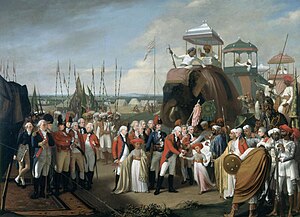
General Lord Cornwallis receiving Tipu Sultan's sons as hostages, by Robert Home, c. 1793
British General Charles Cornwallis, the Earl Cornwallis, was appointed in February 1786 to serve as both Commander-in-Chief of British India and Governor of the Presidency of Fort William, also known as the Bengal Presidency. He oversaw the consolidation of British control over much of peninsular India, setting the stage for the British Raj. He was also instrumental in enacting administrative and legal reforms that fundamentally altered civil administration and land management practices there. According to historian Jerry Dupont, Cornwallis was responsible for "laying the foundation for British rule throughout India and setting standards for the services, courts, and revenue collection that remained remarkably unaltered almost to the end of the British era."
He was raised to the title of Marquess Cornwallis in 1792 as recognition for his performance in the Third Anglo-Mysore War, in which he extracted significant concessions from the Mysorean ruler, Tipu Sultan. Returned to England in 1793, he was engaged in administrative and diplomatic postings until 1798, when he was posted to the Kingdom of Ireland as Lord Lieutenant and Commander-in-Chief. In 1801, he was again posted to India. He arrived in July 1805 and died in October in Ghazipur. (Full article...) -
Image 13
The 1995 India cyclone was a tropical cyclone that struck southeastern India which later spawned a rare snowstorm in Nepal, triggering the deadliest mountain trekking incident in the country's history in November 1995. The storm originated from the monsoon trough on November 7 in the Bay of Bengal, east of India, becoming the penultimate storm of the 1995 North Indian Ocean cyclone season. Moving northwestward, the system gradually intensified while moving toward land, eventually developing an eye in the middle of the convection. Reaching peak winds of at least 120 km/h (75 mph), the India Meteorological Department (IMD) classified the system as a very severe cyclonic storm on November 8, in line with intensity estimates from the American-based Joint Typhoon Warning Center (JTWC). On November 9, the cyclone made landfall near the border of Andhra Pradesh and Orissa. A typical for most November storms, the system continued to the north and dissipated over Nepal on November 11.
In India, the cyclone's strong winds were accompanied by heavy rainfall and a storm surge of 1.5 m (4.9 ft) that inundated the coastline several hundred feet inland. Power lines, crops, and houses were damaged, and many boats were damaged, causing several nautical fatalities. The cyclone killed at least 128 people in India, with hundreds remaining unaccounted for, and damage was estimated at RS$1.1 billion (US$32.2 million). In neighboring Bangladesh, high waves killed 45 people after sinking or sweeping away four ships. The cyclone later spawned a rare November snowstorm across eastern Nepal, with depths reaching 2,000 mm (79 in). The snowfall occurred without warning amid the busy mountain trekking season, and there were several avalanches and landslides across the country. One such incident killed 24 people at a lodge near Gokyo, and there were 63 deaths related to the cyclone in the country. The Nepal government launched the largest search and rescue mission in the country's history, rescuing 450 people, some of whom trapped for days in the snow. (Full article...) -
Image 14
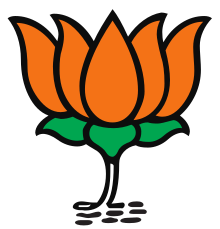
The Bharatiya Janata Party (BJP, [bʱaːɾətiːjə dʒənətaː paːɾʈiː] ⓘ; lit. 'Indian People's Party') is a political party in India and one of the two major Indian political parties alongside the Indian National Congress. Since 2014, it has been the ruling political party in India under the incumbent Prime Minister Narendra Modi. The BJP is aligned with right-wing politics and has close ideological and organisational links to the Rashtriya Swayamsevak Sangh (RSS), a far-right paramilitary organisation. Its policies adhere to Hindutva, a Hindu nationalist ideology. As of January 2024,[update] it is the country's biggest political party in terms of representation in the Parliament of India as well as state legislatures.
The party's origins lie in the Bharatiya Jana Sangh, which was founded in 1951 by Indian politician Syama Prasad Mukherjee, after he left Hindu Mahasabha to form a party as the political wing of RSS. After the Emergency of 1975–1977, the Jana Sangh merged with several other political parties to form the Janata Party; it defeated the then-incumbent Indian National Congress in the 1977 general election. After three years in power, the Janata Party dissolved in 1980, with the members of the erstwhile Jana Sangh reconvening to form the modern-day BJP. Although initially unsuccessful—winning only two seats in the 1984 general election, it grew in strength on the back of the movement around Ram Janmabhoomi in Uttar Pradesh. Following victories in several state elections and better performances in national elections, the BJP became the largest political party in the Parliament in 1996; however, it lacked a majority in the lower house of Parliament, and its government, under its then-leader Atal Bihari Vajpayee, lasted for only 13 days. (Full article...) -
Image 15The 2015–16 season was the third in the history of Bengaluru Football Club. It began on 1 June 2015 and concluded on 31 May 2016, with competitive matches occurring between January and May. The club ended their I-League campaign as champions for the second time, only winning by two points ahead of second placed Mohun Bagan. In the Federation Cup, Bengaluru were eliminated early in the first round, suffering defeat to Aizawl. In the AFC Cup, Bengaluru managed to make it past the Round of 16, defeating Kitchee. The victory had qualified the club for the quarter-finals which would take place the next season.
Prior to the start of the season, Bengaluru were very active making squad changes. Players who have been with the club since their first season such as Sean Rooney and domestic players Darren Caldeira, Malemngamba Meitei, Pawan Kumar, and Robin Singh left after their contracts expired. Club captain Sunil Chhetri and midfielder Thoi Singh had also left the club for Indian Super League clubs Mumbai City and Chennaiyin respectively. Both would return on loan after the 2015 ISL season. Forward Kim Song-yong was signed by head coach Ashley Westwood to replace Rooney. Midfielder Michael Collins was signed a couple weeks after the start of the I-League season as an injury replacement to Josh Walker. Indian youth internationals Amrinder Singh and Seiminlen Doungel were also brought in by Westwood, alongside young prospects Daniel Lalhlimpuia, Malsawmzuala, and Nishu Kumar from the AIFF Elite Academy. (Full article...) -
Image 16Manam (transl. Us) is a 2014 Indian Telugu-language fantasy drama film written and directed by Vikram Kumar, and produced by the Akkineni Family under the Annapurna Studios banner. The film stars Akkineni Nageswara Rao, Nagarjuna, Naga Chaitanya, Samantha Ruth Prabhu and Shriya Saran. The film is set in various time periods, over the course of a hundred years up until 2013, and deals with the concepts of rebirth and eternal love. The plot features a wealthy businessman, Nageswara Rao (Nagarjuna), attempting to bring a young couple together resembling his deceased parents and the elderly Chaitanya's (Nageswara Rao) attempts to bring the businessman and a doctor together. They resemble Chaitanya's deceased parents, who died because of a mistake committed by him in his childhood.
The film was made with a budget of ₹28 crore ($4.6 million). Harsha Vardhan wrote the film's dialogues, while Anup Rubens composed the film's music. P. S. Vinod handled the film's cinematography and Prawin Pudi edited the film. Production began on 3 June 2013. Principal photography began on 7 June 2013 and was shot in and around Hyderabad, Coorg and Mysore till mid April 2014. (Full article...) -
Image 17Kumbalangi Nights (transl. Nights of Kumbalangi) is a 2019 Indian Malayalam-language drama film directed by Madhu C. Narayanan. The directorial debut was written by Syam Pushkaran and jointly produced by Fahadh Faasil and Nazriya Nazim under their production house Fahadh Faasil and Friends, in association with Dileesh Pothan and Syam Pushkaran under Working Class Hero. The film stars Shane Nigam, Fahadh Faasil, Soubin Shahir and Sreenath Bhasi, along with debutants Anna Ben, Grace Antony and Mathew Thomas in pivotal roles. The cinematography and editing were handled by Shyju Khalid and Saiju Sreedharan, respectively. The soundtrack and background score is composed by Sushin Shyam.
Set in the eponymous fishing village of Kumbalangi in Kochi, Kerala, the film centres on the strained relationship between four brothers living together in a dysfunctional home, and how they ultimately stand up for each other as a family. Pushkaran came up with the idea for the film based on the time he spent in the village in his twenties. In 2011, he discussed the story with then-assistant director Narayanan, who decided to make his directorial debut with it. By 2016, Faasil and Pothan, both of whom had worked closely with Narayanan and Pushkaran on previous films, had agreed to co-produce the film. Narayanan then spent a year in Kumbalangi to understand its culture better, before shooting began in September 2018. (Full article...) -
Image 18Raja Ravi Varma's lithograph on Mandodari
Mandodari (Sanskrit: मंदोदरी, Mandodarī, lit. "soft-bellied";) was the queen consort of Ravana, the king of Lanka, according to the Hindu epic Ramayana. The Ramayana describes her as beautiful, pious, and righteous. She is extolled as one of the Panchakanya, the recital of whose names is believed to dispel sin.
Mandodari was the daughter of Mayasura, the King of the Asuras (demons), and the apsara (celestial nymphs) Hema. She marries Ravana and bears three sons: Meghanada (Indrajit), Atikaya and Akshayakumara. According to some Ramayana adaptations, Mandodari is also the mother of Rama's wife Sita, who is infamously kidnapped by Ravana. Despite her husband's faults, Mandodari loves him and advises him to follow the path of righteousness. She repeatedly advises Ravana to return Sita to Rama, but her advice falls on deaf ears. Her love and loyalty to Ravana are praised in the Ramayana. (Full article...) -
Image 19
Fakhruddin Ali Ahmed (13 May 1905 – 11 February 1977) was an Indian lawyer and politician who served as the fifth president of India from 1974 to 1977.
Born in Delhi, Ahmed studied in Delhi and Cambridge and was called to the bar from the Inner Temple, London in 1928. Returning to India, he practiced law in Lahore and then in Guwahati. Beginning a long association with the Indian National Congress in the 1930s, Ahmed was finance minister of Assam in the Gopinath Bordoloi ministry in 1939. He became the Advocate General of Assam in 1946, and was finance minister again from 1957 to 1966 under Bimala Prasad Chaliha. He was made a national cabinet minister by Prime Minister Indira Gandhi in 1966 and was in charge of various ministries including Power, Irrigation, Industries and Agriculture. He was elected president of India over Tridib Chaudhuri in 1974. (Full article...) -
Image 20Aagadu (transl. He won’t stop) is a 2014 Indian Telugu-language action comedy film directed by Srinu Vaitla. Written by Anil Ravipudi, Upendra Madhav and Praveen Varma, the film was jointly produced by Ram Achanta, Gopi Achanta and Anil Sunkara under their banner 14 Reels Entertainment. It stars Mahesh Babu, Tamannaah Bhatia and Sonu Sood in lead roles while Rajendra Prasad, Ashish Vidyarthi, Nassar, and Brahmanandam play supporting roles.
Aagadu was Thaman S's 50th film as a music composer, with K. V. Guhan as the cinematographer and M. R. Varma as the editor. Mahesh played Shankar, an encounter specialist who becomes the circle inspector of police in Bukkapatnam. He is tasked with stopping the power plant construction by Damodar (Sonu Sood), a crime boss, due to its environmental impact. Shankar later learns that Damodar is responsible for his brother Bharath's death, leading him to seek revenge. (Full article...) -
Image 21Kadhalikka Neramillai (transl. No Time for Love) is a 1964 Indian Tamil-language romantic comedy film produced and directed by C. V. Sridhar, who also conceived and co-wrote its script with Chitralaya Gopu. The film features an ensemble cast consisting of Balaiah, Muthuraman, Nagesh, Rajasree, Sachu, Ravichandran and Kanchana. The latter two made their acting debut with this film.
The plot of Kadhalikka Neramillai revolves around Viswanathan, an estate owner who hopes to get his daughters Nirmala and Kanchana married to wealthy grooms. However, Nirmala falls in love with Ashok, a poor man who was once employed by Vishwanathan. To earn Viswanathan's approval, Ashok pretends to be the only heir of a rich businessman; he is supported by his friend Vasu, who poses as Ashok's fictional millionaire father Chidambaram. A comedy of errors ensues when Vasu discovers his lover Kanchana is Viswanathan's other daughter. (Full article...) -
Image 22
Nandanar (also spelt as Nantanar), also known as Thirunaallaippovaar (transl. The one who will go tomorrow) and Tirunallaipovar Nayanar, was a Nayanar saint, who is venerated in the Hindu sect of Shaivism. He is the only Dalit saint in the Nayanars. He is generally counted as the eighteenth in the list of 63 Nayanars. Like the other Nayanars, he was a devout devotee of the god Shiva.
The tale of Nandanar is retold numerous times in folk tales, folk music, plays, films and literature in Tamil society. While Nandanar is included in Nayanar list since the 8th century CE, the 12th century CE Periya Puranam gives a full hagiographical account of his life. The tale focuses on two miracles attributed to him. In Sivalokanathar Temple, Tirupunkur; his prayers are said to have moved a giant stone bull, which still appears in the moved position in the temple. Nandanar is said to have ritually purified himself by fire at Thillai Nataraja Temple, Chidambaram. Nandar's tale features in temple lore and religious literature related to both these temples. Gopalakrishna Bharati's 19th-century retelling of the saint's life remains the basis of many later retellings. It expands the original narrative adding elements of oppression of the Dalit saint by higher castes. While the original account of the Periya Puranam focuses on the saint's observance of caste norms, Dalit retellings emphasize his exploitation and superior religiosity. (Full article...) -
Image 23
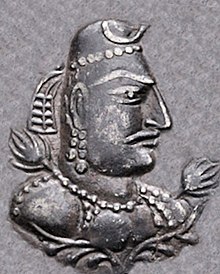
The Alchon Huns, (Bactrian: αλχον(ν)ο Alkhon(n)o or αλχαν(ν)ο Alkhan(n)o) also known as the Alkhan, Alchono, Alxon, Alkhon, Alakhana, and Walxon, were a nomadic people who established states in Central Asia and South Asia during the 4th and 6th centuries CE. They were first mentioned as being located in Paropamisus, and later expanded south-east, into the Punjab and Central India, as far as Eran and Kausambi. The Alchon invasion of the Indian subcontinent eradicated the Kidarite Huns who had preceded them by about a century, and contributed to the fall of the Gupta Empire, in a sense bringing an end to Classical India.
The invasion of India by the Huna peoples follows invasions of the subcontinent in the preceding centuries by the Yavana (Indo-Greeks), the Saka (Indo-Scythians), the Pahlava (Indo-Parthians), and the Kushana (Yuezhi). The Alchon Empire was the second of four major Huna states established in Central and South Asia. The Alchon were preceded by the Kidarites and succeeded by the Hephthalites in Bactria and the Nezak Huns in the Hindu Kush. The names of the Alchon kings are known from their extensive coinage, Buddhist accounts, and a number of commemorative inscriptions throughout the Indian subcontinent. (Full article...) -
Image 24

Srinivasa Ramanujan Aiyangar
(22 December 1887 – 26 April 1920) was an Indian mathematician. Often regarded as one of the greatest mathematicians of all time, though he had almost no formal training in pure mathematics, he made substantial contributions to mathematical analysis, number theory, infinite series, and continued fractions, including solutions to mathematical problems then considered unsolvable.
Ramanujan initially developed his own mathematical research in isolation. According to Hans Eysenck, "he tried to interest the leading professional mathematicians in his work, but failed for the most part. What he had to show them was too novel, too unfamiliar, and additionally presented in unusual ways; they could not be bothered". Seeking mathematicians who could better understand his work, in 1913 he began a mail correspondence with the English mathematician G. H. Hardy at the University of Cambridge, England. Recognising Ramanujan's work as extraordinary, Hardy arranged for him to travel to Cambridge. In his notes, Hardy commented that Ramanujan had produced groundbreaking new theorems, including some that "defeated me completely; I had never seen anything in the least like them before", and some recently proven but highly advanced results. (Full article...) -
Image 25Operation Python, a follow-up to Operation Trident, was the code name of a naval attack launched on West Pakistan's port city of Karachi by the Indian Navy during the Indo-Pakistani War of 1971. After the first attack during Operation Trident on the Port of Karachi, Pakistan stepped up aerial surveillance of its coast as the presence of large Indian Navy ships gave the impression that another attack was being planned. Pakistani warships attempted to outsmart the Indian Navy by mingling with merchant shipping. To counter these moves, Operation Python was launched on the night of 8/9 December 1971. A strike group consisting of one missile boat and two frigates attacked the group of ships off the coast of Karachi. While India suffered no losses, Pakistani fleet tanker PNS Dacca was damaged beyond repair, and the Kemari Oil Storage facility was lost. Two other foreign ships stationed in Karachi were also sunk during the attack. (Full article...)
News
- 23 November 2024 –
- Twenty-four people are killed and 46 others are rescued after two boats carrying 70 passengers capsize when the boats' engines failed in the Indian Ocean off the north coast of Madagascar. (BBC News)
- 20 November 2024 –
- Indian billionaire and Adani Group chairman Gautam Adani is indicted in the U.S. for his role in an alleged multi-billion dollar bribery and fraud scheme where he and seven others paid Indian government officials US$265 million to obtain contracts for Adani Green Energy. (AsiaOne) (Bloomberg)
- 15 November 2024 –
- Ten infants are killed and 16 others are injured in a fire inside a neonatal intensive care unit at the Jhansi Medical College hospital in Jhansi, Uttar Pradesh, North India. (AP)
- 13 November 2024 – 2024 Indo-Pakistani smog
- New Delhi, India, reports its 15th consecutive day with a "very poor" recorded air quality index due to significant air pollution causing zero meter visibility smog. (The Hindu)
- 13 November 2024 – Bulldozer Justice
- The Supreme Court of India rules that it is unconstitutional for the government to demolish property belonging to people suspected of crimes without a legal process, a practice common in states ruled by the Bharatiya Janata Party. (The Times of India) (DW)
Did you know...
- ... that Barren Island, located in the Andaman and Nicobar Islands, is the only active volcano in India?
- ... that Jacqueline Kennedy bought several saris during her 1962 tour of India and Pakistan to be turned into sari-inspired dresses?
- ... that Winter Renouf, a British member of the Indian Civil Service, thought that farmers in the Punjab should grow Canadian wheat varieties?
- ... that witch-hunts in India are still prevalent?
- ... that an Egyptian rabbi's authority was invoked in a deed freeing a woman from slavery in 1132 in Mangalore, India?
- ... that in 1884 Motibai Kapadia's father allowed her to study alongside men in India?
Topics related to India
Timeline of Indian history, Indus Valley Civilisation, Dholavira, Science and technology in ancient India, Meluhha, Aryan invasion theory, Out of India theory, Greek conquests in India, Indian maritime history, Maurya Empire, Ashoka, Shunga Empire, Hoysala Empire, Vijayanagara, Satavahana dynasty, Indo-Greek Kingdom, Indo-Scythians, Indo-Parthian Kingdom, Kushan Empire, Western Satraps, Gupta Empire, Chola dynasty, Pala Empire, Islamic incursions in India, Mughal Empire, Maratha Empire, British Raj, East India Company, Governor-General, Viceroy, War of Independence, 1857, Indian independence movement, Indian National Army, Azad Hind, Quit India Movement, Partition of India, History of Republic of India, Non-Aligned Movement, Sino-Indian War, Indo-Pakistani War of 1947–1948, Indo-Pakistani War of 1965, Indo-Pakistani War of 1971, Kargil War, 2001–02 India–Pakistan standoff, Military, Demographic
Law, Hindu law, Constitution, Political parties (Indian National Congress, Bharatiya Janata Party), Foreign relations, Elections, Political divisions, Reservation in India
Government agencies, Legislative branch (Lok Sabha, Rajya Sabha) Executive branch (President & Vice President, Prime Minister & Deputy Prime Minister, Cabinet Ministers, Cabinet Secretary, Election Commission, Foreign Minister; Law enforcement: CBI, CID, Intelligence: IB, RAW), Directorate General of Income Tax Investigation Judicial branch (Supreme Court), Armed Forces (Army, Navy, Air Force, Border Security Force, Coast Guard)
Himalayas, Western Ghats, Eastern Ghats, Indo-Gangetic Plain, Deccan Plateau, Thar Desert, Ganges, Rann of Kutch, Brahmaputra River, Northeast India; Mountains, Valleys, Islands, Rivers; States and union territories, Cities, Districts, Regions, Fauna, Flora
Rupee, Bombay Stock Exchange, National Stock Exchange, Standard of living, Companies, Reserve Bank of India, Energy policy (Solar, Wind, Nuclear), Tourism, Transport (Expressways, Rail transport, Auto rickshaw),
Languages, Standard of living, Religion
Music (Carnatic, Hindustani, Indi-pop), Dance, Languages, Literature, Architecture, Film & TV, Cuisine, Holidays, Folklore, Education, Media, Indian martial arts
Indian Council of Agricultural Research (ICAR), Indian Institute of Astrophysics, National Centre for Software Technology, AIIMS, IISc, IIT, NIT, BITS-Pilani, INRegistry, Indian numbering system, Indian Space Research Organisation, National Internet Exchange of India, ICRISAT, International Institute of Information Technology, Hyderabad
Indian English, Indian nationality law, Numbering system, Indian Space Research Organisation, Telecommunications, National Highways Development Project, Flag, Vehicle registration plates, Indian nationalism, Metrication in India
Categories
Related portals
Religions in India
Indian Subcontinent
Other countries
Wikipedias in Indian languages
- অসমীয়া (Assamese)
- বাংলা (Bengali)
- भोजपुरी (Bhojpuri)
- বিষ্ণুপ্রিয়া মণিপুরী (Bishnupriya Manipuri)
- गोंयची कोंकणी / Gõychi Konknni (Konkani)
- ગુજરાતી (Gujarati)
- हिन्दी (Hindi)
- ಕನ್ನಡ (Kannada)
- कॉशुर/كشميري (Kashmiri)
- मैथिली (Maithili)
- മലയാളം (Malayalam)
- मराठी (Marathi)
- नेपाली (Nepali)
- नेपाल भाषा
- (Newari)
- ଓଡ଼ିଆ (Odiya)
- ਪੰਜਾਬੀ (Punjabi)
- पालि (Pali)
- संस्कृत (Sanskrit)
- ᱥᱟᱱᱛᱟᱲᱤ (Santali)
- سنڌي (Sindhi)
- தமிழ் (Tamil)
- తెలుగు (Telugu)
- ತುಳು (Tulu)
- اردو (Urdu)
Associated Wikimedia
The following Wikimedia Foundation sister projects provide more on this subject:
-
Commons
Free media repository -
Wikibooks
Free textbooks and manuals -
Wikidata
Free knowledge base -
Wikinews
Free-content news -
Wikiquote
Collection of quotations -
Wikisource
Free-content library -
Wikiversity
Free learning tools -
Wikivoyage
Free travel guide -
Wiktionary
Dictionary and thesaurus






